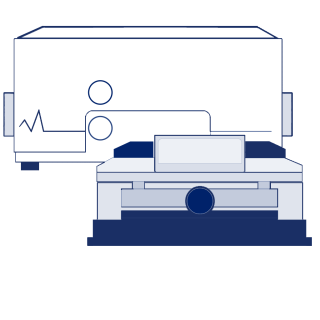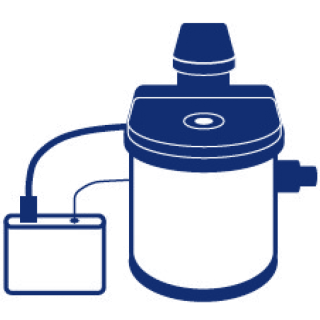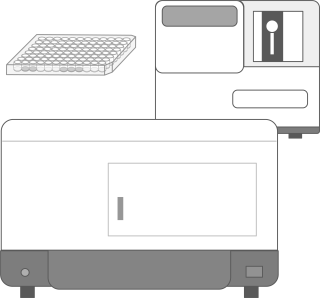ダウンロード/資料請求
参考文献
アトーの分析機器や試薬を使って行われた研究論文や、雑誌・書籍等の記事リストです。
Cellgraph (AB-3000B)
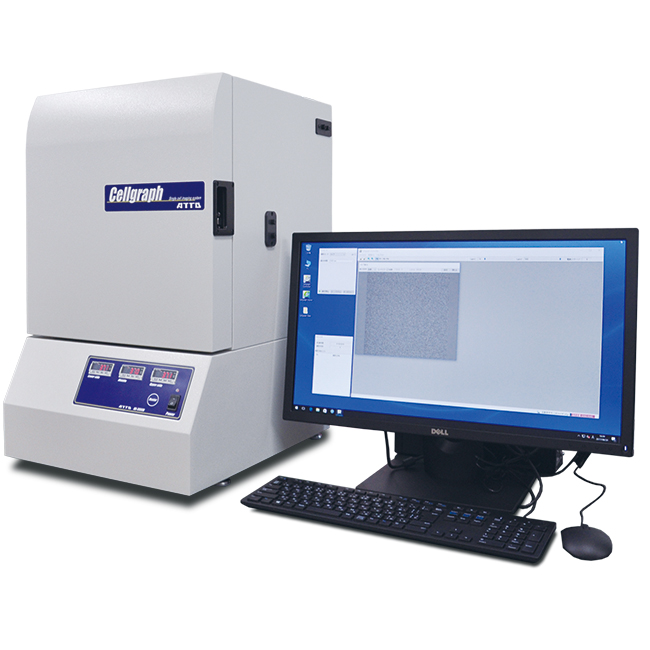
セルグラフは、生細胞や培養組織における遺伝子発現の経過を、ルシフェラーゼ等による生物発光(Bioluminescence)で捉えることが出来るリアルタイム・イメージングシステムです。
- H. Hoshino, Y. Nakajima and Y. Ohmiya, Luciferase-YFP fusion tag with enhanced emission for single-cell luminescence imaging. Nature Methods, 4(8), 637-639 (2007)[PubMed]
- C. Wu, K. Mino, H. Akimoto, M. Kawabata, K. Nakamura, M. Ozaki and Y. Ohmiya, In vivo far-red luminescence imaging of a biomarker based on BRET from Cypridina bioluminescence to an organic dye. Proc. Natl. Acad. Sci. U.S.A., 106(37), 15599-15603 (2009)[PubMed]
- Y. Nakajima, T. Yamazaki, S. Nishii, T. Noguchi, H. Hoshino, K. Niwa, V. R. Viviani and Y. Ohmiya, Enhanced beetle luciferase for high-resolution bioluminescence imaging. PLoS One, 5(4), e10011 (2010)[PubMed]
- H. Kwon, T. Enomoto, M. Shimogawara, K. Yasuda, Y. Nakajima and Y. Ohmiya, Bioluminescence imaging of dual gene expression at the single-cell level.Biotechniques, 48(6), 460-462 (2010)[PubMed]
- X. Li, Y. Nakajima, K. Niwa, VR. Viviani and Y. Ohmiya, Enhanced red-emitting railroad worm luciferase for bioassays and bioimaging. Protein Sci., 19, 26-33 (2010)[PubMed]
- Y. Nakajima and Y. Ohmiya, Bioluminescence assays: multicolor luciferase assay, secreted luciferase assay and imaging luciferase assay. Expert. Opin. Drug Discov., 5(9), 835-849 (2010)[PubMed]
- H. Kwon, Y. Ohmiya, K. Honma, S. Honma, T. Nagai, K. Saito and K. Yasuda, Synchronized ATP oscillations have a critical role in prechondrogenic condensation during chondrogenesis. Cell Death Disease, 3. e278 (2012)[PubMed]
- C.Wu, KY. Wang, X. Guo, M. Sato, M. Ozaki, S. Shimajiro, Y. Ohmiya and Y. Sasaguri, Rapid methods of detecting the target molecule in immunohistology using a bioluminescence probe. Luminescence, 28(1), 38-43 (2013)[PubMed]
- HK. Choe, HD. Kim, SH. Park, HW. Lee, JY. Park, JY. Seong, SL. Lightman, GH. Son and K. Kim, Synchronous activation of gonadotropin-releasing hormone gene transcription and secretion by pulsatile kisspeptin stimulation. Proc. Natl. Acad.Sci. U.S.A.,110(14),5677-5682 (2013)[PubMed]
- HJ. Kwon, Y. Ohmiya and K. Yasuda, Dual-color system for simultaneously monitoring intracellular Ca2+ and ATP dynamics. Anal. Biochem., 430(1), 45-47 (2012)[PubMed]
- S. Koinuma, T. Asakawa, M. Nagano, K. Furukawa, M. Sujino, K. Masumoto, Y. Nakajima, S. Hashimoto, K. Yagita, Y. Shigeyoshi, Regional circadian period difference in the suprachiasmatic nucleus of the mammalian circadian center. Eur. J. Neurosci., 38(6), 2832-41 (2013)[PubMed]
- SK. Chun, J. Jang, S. Chung, H. Yun, NJ. Kim, JW. Jung, GH. Son, YG. Suh and K. Kim, Identification and Validation of Cryptochrome Inhibitors That Modulate the Molecular Circadian Clock. ACS Chem. Biol., 9(3), 703-10 (2014)[PubMed]
- M. Yasunaga, Y. Nakajima and Y. Ohmiya, Dual-color bioluminescence imaging assay using green- and red-emitting beetle luciferases at subcellular resolution. Anal. Bioanal. Chem., 406(23), 5735-5742 (2014)[PubMed]
- D. Ono, S. Honma and K. Honma, Cryptochromes are critical for the development of coherent circadian rhythms in the mouse suprachiasmatic nucleus. Nat. Commun., 4, 1666 (2013)[PubMed]
- M. Yasunaga, K. Murotomi, H. Abe, T. Yamazaki, S. Nishii, T. Ohbayashi, M. Oshimura, T. Noguchi, K. Niwa, Y. Ohmiya and Y. Nakajima, Highly sensitive luciferase reporter assay using a potent destabilization sequence of calpain 3. J. Biotechnol., 194, 115-123 (2015)[PubMed]
- J. Koo, HK. Choe, HD. Kim, SK. Chun, GH. Son, K. Kim, Effect of Mefloquine, a Gap Junction Blocker, on Circadian Period2 Gene Oscillation in the Mouse Suprachiasmatic Nucleus Ex Vivo. Endocrinol. Metab., 30(3), 361-370 (2015)[PubMed]
- IT. Tokuda, D. Ono, B. Ananthasubramaniam, S. Honma, K. Honma and H. Herzel, Coupling Controls the Synchrony of Clock Cells in Development and Knockouts. Biophys. J., 109(10), 2159-2170 (2015)[PubMed]
- M. Yasunaga, Y. Fujita, R. Saito, M. Oshimura and Y. Nakajima, Continuous long-term cytotoxicity monitoring in 3D spheroids of beetle luciferase-expressing hepatocytes by nondestructive bioluminescence measurement. BMC Biotechnol., 17(1):54 (2017)[PubMed]
- T. Enomoto, H. Kubota, K. Mori, M. Shimogawara, M. Yoshita, Y. Ohmiya and H. Akiyama, Absolute bioluminescence imaging at the single-cell level with a light signal at the Attowatt level. Biotechniques, 64(6), 270-274 (2018)[PubMed]
- IT. Tokuda, D. Ono, S. Honma, K. Honma, H. Herzel, Coherency of circadian rhythms in the SCN is governed by the interplay of two coupling factors. PLoS Comput. Biol., 14(12), e1006607 (2018)[PubMed]
- GV. de Mello Gabriel, R. Yasuno, Y. Mitani, Y. Ohmiya and VR. Viviani, Novel application of Macrolampis sp2 firefly luciferase for intracellular pH-biosensing in mammalian cells. Photochem. Photobiol. Sci., 18(5), 1212-1217 (2019)[PubMed]
- S. Yun, EJ. Lee, HK. Choe, GH. Son, K. Kim and S. Chung, Programming effects of maternal stress on the circadian system of adult offspring. Exp. Mol. Med., 52(3), 473-484 (2020)[PubMed]
- M.Doi, M. Sato and Y. Ohmiya, In vivo simultaneous analysis of gene expression by dual-color luciferases in Caenorhabditis elegans. Int. J. Mol. Sci., 22(1), 119 (2020)[PubMed]
Kronos Dio(AB-2550)
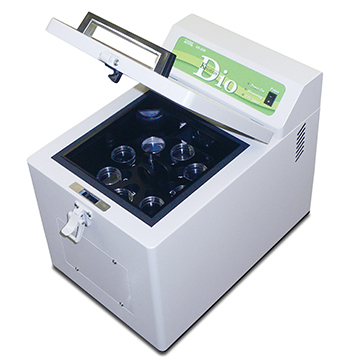
クロノスDioは、複数のディッシュで培養しながら細胞や組織におけるダイナミックな変化を、ルシフェラーゼによる生物発光の変動として検出する装置です。
- (Hormone, CRE) P. J. He, Y. Fujimoto, N. Yamauchi and M. Hattori, Real-time monitoring of cAMP response element binding protein signaling in porcine granulosa cells modulated by ovarian factors. Mol. Cell. Biochem., 290(1-2), 177-184 (2006)[PubMed]
- (Gene silencing by siRNA) F. Sato, M. Kurokawa, N. Yamauchi and M. Hattori, Gene silencing of myostatin in differentiation of chicken embryonic myoblasts by small interfering RNA. Am. J. Physiol., Cell physiol., 291(3), C538-C545 (2006)[PubMed]
- (Clock gene) I. Kwon, J. Lee, S. H. Chang, N. C. Jung, B. J. Lee, G. H. Son, K. Kim and K. H. Lee, BMAL1 shuttling controls transactivation and degradation of the CLOCK/BMAL1 heterodimer. Mol. Cell. Biol., 26(19), 7318-7330 (2006)[PubMed]
- (Clock gene) A. Fujioka, N. Takashima and Y. Shigeyoshi, Circadian rhythm generation in a glioma cell line. Biochem. Biophys. Res. Commun., 346(1), 169-174 (2006)[PubMed]
- (Clock gene) S. Nishide, S. Honma, Y. Nakajima, M. Ikeda, K. Baba, Y. Ohmiya and K. Honma, New reporter system for Per1 and Bmal1 expressions revealed self-sustained circadian rhythms in peripheral tissues. Genes Cells, 11, 1173-1182 (2006) [PubMed]
- (Clock gene) P. J. He, M. Hirata, N. Yamauchi, S. Hashimoto and M. Hattori, The disruption of circadian clockwork in differentiating cells from rat reproductive tissues as identified by in vitro real-time monitoring system. J. Endocrinol., 193, 413-420 (2007)[PubMed]
- (Hormone, PRE) H. Fukuda, P. J. He, K. Yokota, T. Soh, N. Yamauchi and M. Hattori, Progesterone-dependent and -independent expression of the multidrug resistance type I gene in porcine granulosa cells. Mol. Cell. Biochem., 298, 179-186 (2007)[PubMed]
- (Clock gene) P. J. He, M. Hirata, N. Yamauchi, S. Hashimoto and M. Hattori, Gonadotropic regulation of circadian clockwork in rat granulose cells. Mol. Cell. Biochem., 302, 111-118 (2007)[PubMed]
- (Clock gene) T. Ohno, Y. Ohnishi and N. Ishida, A novel E4BP4 element drives circadian expression of mPeriod2. Nucleic Acids Res., 35(2), 648-655 (2007)[PubMed]
- (Clock gene) H. S. Shim, H. Kim, J. Lee, G. H. Son, S. Cho, T. H. Oh, S. H. Kang, D. S. Seen, K. H. Lee and K. Kim, Rapid activation of CLOCK by Ca2þ-dependent protein kinase C mediates resetting of the mammalian circadian clock. EMBO rep., 8, 366-371 (2007)[PubMed]
- (Clock gene) J. Hirayama, S. Sahar, B. Grimaldi, T. Tamaru, K. Takamatsu, Y. Nakahata and P. Sassone-Corsi, CLOCK-mediated acetylation of BMAL1 controls circadian function. Nature, 450, 1086-1090 (2007)[PubMed]
- (Dual color luciferase, Clock gene) T. Noguchi, M. Ikeda, Y. Ohmiya and Y. Nakajima, Simultaneous monitoring of independent gene expression patterns in two types of cocultured fibroblasts with different color-emitting luciferases. BMC Biotechnol., 8:40 (2008)[PubMed]
- (Clock gene) M. Akashi, N. Hayasaka, S. Yamazaki and K. Node, Mitogen-activated protein kinase is a functional component of the autonomous circadian system in the suprachiasmatic nucleus. J. Neurosci., 28(18), 4619-4623 (2008)[PubMed]
- (DDS, Gene transfection) S. Takae, K. Miyata, M. Oba, T. Ishii, N. Nishiyama, K. Itaka, Y. Yamasaki, H. Koyama, and K. Kataoka, PEG-detachable polyplex micelles based on disulfide-linked block catiomers as bioresponsive nonviral gene vectors. J. Am. Chem. Soc., 130, 6001-6009 (2008)[PubMed]
- (Clock gene) Y. Onishi, S. Hanai, T. Ohno, Y. Hara and N. Ishida, Rhythmic SAF-A binding underlies circadian transcription of the Bmal1 gene. Mol. Cell. Biol., 28(10), 3477-3488 (2008)[PubMed]
- (Clock gene) J. Lee, Y. Lee, M. J. Lee, E. Park, S. H. Kang, C. H. Chung, K. H. Lee and K. Kim, Dual modification of BMAL1 by SUMO2/3 and ubiquitin promotes circadian activation of the CLOCK/BMAL1 complex. Mol. Cell. Biol., 28(19), 6056-6065 (2008)[PubMed]
- (Clock gene) A. Yoshikawa, H. Shimada, K. Numazawa, T. Sasaki, M. Ikeda, M. Kawashima, N. Kato, K. Tokunaga and T. Ebisawa, Establishment of human cell lines showing circadian rhythms of bioluminescence. Neurosci. Lett., 446, 40-44 (2008)[PubMed]
- (Clock gene) Y. Yamanaka, S. Honma and K. Honma, Scheduled exposures to a novel environment with a running-wheel differentially accelerate re-entrainment of mice peripheral clocks to new light–dark cycles. Genes to Cells, 13, 497-507 (2008)[PubMed]
- (Clock gene) N. Kon, T. Hirota, T. Kawamoto, Y. Kato, T. Tsubota and Y. Fukada, Activation of TGF-β/activin signalling resets the circadian clock through rapid induction of Dec1 transcripts. Nature Cell Biol., 10(12), 1463-1469 (2008)[PubMed]
- (DDS, Gene transfection) M. Oba, K. Aoyagi, K. Miyata, Y. Matsumoto, K. Itaka, N. Nishiyama, Y. Yamasaki, H. Koyama and K. Kataoka, Polyplex micelles with cyclic RGD peptide ligands and disulfide cross-links directing to the enhanced transfection via controlled intracellular trafficking. Mol. Pharm., 5(6), 1080-1092 (2008)[PubMed]
- (Clock gene) K. Ohsaki, K. Oishi, Y. Kozono, K. Nakayama, K. I. Nakayama and N. Ishida, The role of β-TrCP1 and β-TrCP2 in circadian rhythm generation by mediating degradation of clock protein PER2. J. Biochem., 144(5), 609-618 (2008)[PubMed]
- (Clock gene) S. Nishide, S. Honma and K. Honma, The circadian pacemaker in the cultured suprachiasmatic nucleus from pup mice is highly sensitive to external perturbation. Eur. J. Neurosci., 27(19), 2686-2690 (2008)[PubMed]
- (Clock gene) F. Yang, Y. Nakajima, M. Kumagai, Y. Ohmiya and M. Ikeda, The molecular mechanism regulating the autonomous circadian expression of Topoisomerase I in NIH3T3 cells. Biochem. Biophys. Res. Commun., 380(1), 22-27 (2009)[PubMed]
- (Clock gene, Hormone) S. Koinuma, K. Yagita, A. Fujioka, N. Takashima, T. Takumi and Y. Shigeyoshi, The resetting of the circadian rhythm by Prostaglandin J2 is distinctly phase-dependent. FEBS Lett., 583, 413-418 (2009)[PubMed]
- (Apoptosis) A. Kanno, Y. Umezawa and T. Ozawa, Detection of apoptosis using cyclic luciferase in living mammals. Methods Mol. Biol., 574, 105-114 (2009)[PubMed]
- (Clock gene, Hormone) M. Hirata, PJ. He, N. Shibuya, M. Uchikawa, N. Yamauchi, S. Hashimoto and M. Hattori, Progesterone, but not estradiol, synchronizes circadian oscillator in the uterus endometrial stromal cells. Mol. Cell. Biochem., 324(1-2), 31-38 (2009)[PubMed]
- (Differenciation) M. Kurokawa, F. Sato, S. Aramaki, T. Soh, N. Yamauchi and M. Hattori, Monitor of the myostatin autocrine action during differentiation of embryonic chicken myoblasts into myotubes: effect of IGF-I. Mol. Cell. Biochem., 331(1-2), 193-199 (2009)[PubMed]
- (Clock gene) M. Sasaki, H. Yoshitane, NH. Du, T. Okano and Y. Fukada, Preferential inhibition of BMAL2-CLOCK activity by PER2 reemphasizes its negative role and a positive role of BMAL2 in the circadian transcription. J. Biol. Chem., 284(37), 25149-25159 (2009)[PubMed]
- (Glycogenesis, Clock gene) R. Doi, K. Oishi and N. Ishida, CLOCK regulates circadian rhythms of hepatic glycogen synthesis through transcriptional activation of Gys2. J. Biol. Chem., 285(29), 22114-22121 (2010)[PubMed]
- (Apoptosis, Clock gene) K. Yoshida, P. He, N. Yamauchi, S. Hashimoto and M. Hattori, Up-regulation of circadian clock gene Period 2 in the prostate mesenchymal cells during flutamide-induced apoptosis. Mol. Cell. Biochem., 335(1-2), 37-45 (2010)[PubMed]
- (Clock gene) Y. Lee, J. Lee, I. Kwon, Y. Nakajima, Y. Ohmiya, GH. Son, KH. Lee and K. Kim, Coactivation of the CLOCK-BMAL1 complex by CBP mediates resetting of the circadian clock. J. Cell Sci., 123(20), 3547-3557 (2010)[PubMed]
- (Clock gene) T. Hirota, N. Kon, T. Itagaki, N. Hoshina, T. Okano, Y. Fukada, Transcriptional repressor TIEG1 regulates Bmal1 gene through GC box and controls circadian clockwork. Genes Cells., 15(2), 111-121 (2010)[PubMed]
- (cAMP monitoring) M. Takeuchi, Y. Nagaoka, T. Yamada, H. Takakura and T. Ozawa, Ratiometric bioluminescence indicators for monitoring cyclic adenosine 3',5'-monophosphate in live cells based on luciferase-fragment complementation. Anal. Chem., 82(22), 9306-9313 (2010)[PubMed]
- (DDS, Gene transfection) K. Miyata, N. Gouda, H. Takemoto, M. Oba, Y. Lee, H. Koyama, Y. Yamasaki, K. Itaka, N. Nishiyama, K. Kataoka, Enhanced transfection with silica-coated polyplexes loading plasmid DNA. Biomaterials, 31(17), 4764-4770 (2010)[PubMed]
- (Gene therapy) M. Oba, Y. Vachutinsky, K. Miyata, M. R. Kano, S. Ikeda, N. Nishiyama, K. Itaka, K. Miyazono, H. Koyama and K. Kataoka, Antiangiogenic gene therapy of solid tumor by systemic injection of polyplex micelles loading plasmid DNA encoding soluble flt-1. Mol. Pharm., 7(2), 501-509 (2010)[PubMed]
- (Dual color luciferase, Clock gene) T. Noguchi, T. Michihata, W. Nakamura, T. Takumi, R. Shimizu, M. Yamamoto, M. Ikeda, Y. Ohmiya and Y. Nakajima, Dual-color luciferase mouse directly demonstrates coupled expression of two clock genes. Biochemistry, 49(37), 8053-8061 (2010)[PubMed]
- (Clock gene) Y. Onishi, HSG cells, a model in the submandibular clock. Biosci. Rep., 31(1), 57-62 (2011)[PubMed]
- (Stress response, Heat shock protein) J. Sun, C. S. Conn, Y. Han, V. Yeung and SB. Qian, PI3K-mTORC1 attenuates stress response by inhibiting cap-independent Hsp70 translation. J. Biol. Chem., 286(8), 6791-6800 (2011)[PubMed]
- (Clock gene) M. Uchikawa, M. Kawamura, N. Yamauchi and M. Hattori, Down-regulation of circadian clock gene Period 2 in uterine endometrial stromal cells of pregnant rats during decidualization. Chronobiol. Int., 28(1), 1-9 (2011)[PubMed]
- (Apoptosis, Differentiation, Clock gene) G. Chu, K. Yoshida, S. Narahara, M. Uchikawa, M. Kawamura, N. Yamauchi, Y. Xi, Y. Shigeyoshi, S. Hashimoto and M. Hattori, Alterations of circadian clockworks during differentiation and apoptosis of rat ovarian cells. Chronobiol. Int., 28(6), 477-487 (2011)[PubMed]
- (Allergy, Clock gene) Y. Nakamura, D. Harama, N. Shimokawa, M. Hara, R. Suzuki, Y. Tahara, K. Ishimaru, R. Katoh, K. Okumura, H. Ogawa, S. Shibata and A. Nakao, Circadian clock gene Period2 regulates a time-of-day-dependent variation in cutaneous anaphylactic reaction. J. Allergy Clin. Immunol., 127(4), 1038-1045 (2011)[PubMed]
- (Metabolism, Clock gene) H. Oike, K. Nagai, T. Fukushima, N. Ishida and M. Kobori, Feeding cues and injected nutrients induce acute expression of multiple clock genes in the mouse liver. PLoS One, 6(8), e23709 (2011)[PubMed]
- (Food, Clock gene) H. Oike, M. Kobori, T. Suzuki and N. Ishida, Caffeine lengthens circadian rhythms in mice. Biochem. Biophys. Res. Commun., 410(3), 654-658 (2011)[PubMed]
- (Toxicological screening) M. Yasunaga, N. Oumi, M. Osaki, Y. Kazuki, T. Nakanishi, M. Oshimura and K. Sato, Establishment and characterization of a transgenic mouse model for in vivo imaging of bmp4 expression in the pancreas. PLoS One, 6(9), e24956 (2011)[PubMed]
- (siRNA, DDS)RJ. Christie, K. Miyata, Y. Matsumoto, T. Nomoto, D. Menasco, TC Lai, M. Pennisi, K. Osada, S. Fukushima, N. Nishiyama, Y. Yamasaki and K. Kataoka, Effect of polymer structure on micelles formed between siRNA and cationic block copolymer comprising thiols and amidines. Biomacromolecules, 12(9), 3174-3185 (2011)[PubMed]
- (Clock gene) T. Tamaru, M. Hattori, K. Honda, I. Benjamin, T. Ozawa and K. Takamatsu, Synchronization of circadian Per2 rhythms and HSF1-BMAL1:CLOCK interaction in mouse fibroblasts after short-term heat shock pulse. PLoS One, 6(9), e24521 (2011)[PubMed]
- (Clock gene) DY. Kim, E. Kwak, SH. Kim, KH. Lee, KC. Woo and KT. Kim, hnRNP Q mediates a phase-dependent translation-coupled mRNA decay of mouse Period3. Nucleic Acids Res., 39(20), 8901-8914 (2011)[PubMed]
- (Photoreceptor) D. Kojima, S. Mori, M. Torii, A. Wada, R. Morishita and Y. Fukada, UV-sensitive photoreceptor protein OPN5 in humans and mice. PLoS One, 6(10), e26388 (2011)[PubMed]
- (Cell maturation, Clock gene) G. Chu, I. Misawa, H. Chen, N. Yamauchi, Y. Shigeyoshi, S. Hashimoto and M. Hattori, Contribution of FSH and triiodothyronine to the development of circadian clocks during granulosa cell maturation. Am. J. Physiol. Endocrinol. Metab., Epub (2011)[PubMed]
- (Clock gene) Y. Onishi, K. Oishi, Y. Kawano and Y. Yamazaki, The harmala alkaloid harmine is a modulator of circadian Bmal1 transcription. Biosci. Rep., 32(1), 45-52 (2012)[PubMed]
- (Clock gene) S. Nishide, D. Ono, Y. Yamada, S. Honma and K. Honma, De novo synthesis of PERIOD initiates circadian oscillation in cultured mouse suprachiasmatic nucleus after prolonged inhibition of protein synthesis by cycloheximide. Eur. J. Neurosci., 35(2), 291-299 (2012)[PubMed]
- (Apoptosis) M. Ozaki, S. Haga and T. Ozawa, In Vivo Monitoring of Liver Damage Using Caspase-3 Probe. Theranostics, 2(2), 207-214 (2012)[PubMed]
- (Chondrogenesis, ATP oscillations) HJ. Kwon, Y. Ohmiya, K. Honma, S. Honma, T. Nagai, K. Saito and K. Yasuda, Synchronized ATP oscillations have a critical rolein prechondrogenic condensation during chondrogenesis. Cell Death Dis, 3, e278 (2012)[PubMed]
- (Clock gene) H. Chen, G. Chu, L. Zhao, N. Yamauchi, Y. Shigeyoshi, S. Hashimoto and M. Hattori, Rev-erbα regulates circadian rhythms and StAR expression in rat granulosa cells as identified by the agonist GSK4112. Biochem. Biophys. Res. Commun., 420(2), 374-379 (2012)[PubMed]
- (Dual color luciferase, Clock gene) T. Noguchi, M. Ikeda, Y. Ohmiya and Y. Nakajima, A dual-color luciferase assay system reveals circadian resetting of cultured fibroblasts by co-cultured adrenal glands. PLoS One, 7(5), e37093 (2012)[PubMed]
- (siRNA, DDS) RJ. Christie, Y. Matsumoto, K. Miyata, T. Nomoto, S. Fukushima, K. Osada, J. Halnaut, F. Pittella, HJ. Kim, N. Nishiyama and K. Kataoka, Targeted polymeric micelles for siRNA treatment of experimental cancer by intravenous injection. ACS Nano, Epub (2012)[PubMed]
- (Clock gene) H. Yoshitane, S. Honma, K. Imamura, H. Nakajima, S. Nishide, D. Ono, H. Kiyota, N. Shinozaki, H. Matsuki, N. Wada, H. Doi, T. Hamada, K. Honma and Y. Fukada, JNK regulates the photic response of the mammalian circadian clock. EMBO Rep., 13(5), 455-461 (2012)[PubMed]
- (Clock gene) Y. Uchida, T. Osaki, T. Yamasaki, T. Shimomura, S. Hata, K. Horikawa, S. Shibata, T. Todo, J. Hirayama and H. Nishina, Involvement of Stress Kinase Mitogen-activated Protein Kinase Kinase 7 in Regulation of Mammalian Circadian Clock. J. Biol. Chem., 287(11), 8318-26 (2012)[PubMed]
- (ATP, Ca2+, Chondrogenesis) HJ. Kwon, Y. Ohmiya and K. Yasuda, Dual-color system for simultaneously monitoring intracellular Ca2+ and ATP dynamics. Anal. Biochem., 430(1), 45-47 (2012)[PubMed]
- (Clock gene) Y. Onishi and Y. Kawano, Rhythmic binding of Topoisomerase I impacts on the transcription of Bmal1 and circadian period. Nucleic Acids Res., 40(19), 9482-92 (2012)[PubMed]
- (ATP, TGF-β, Chondrogenesis) HJ. Kwon, TGF-β but not BMP signaling induces prechondrogenic condensation through ATP oscillations during chondrogenesis. Biochem. Biophys. Res. Commun., 424(4), 793-800 (2012)[PubMed]
- (Chondrogenesis, ATP oscillations) HJ. Kwon, Extracellular ATP signaling via P2X4 receptor and cAMP/PKA signaling mediate ATP oscillations essential for prechondrogenic condensation. J. Endocrinol., 214(3), 337-48 (2012)[PubMed]
- (siRNA, DDS) N. Gouda, K. Miyata, RJ. Christie, T. Suma, A. Kishimura, S. Fukushima, T. Nomoto, X. Liu, N. Nishiyama, and K. Kataoka, Silica nanogelling of environment-responsive PEGylated polyplexes for enhanced stability and intracellular delivery of siRNA. Biomaterials, 34(2), 562-570 (2013)[PubMed]
- (DDS, Gene transfection) S. Mochizuki, N. Kanegaea, K. Nishina, Y. Kamikawa, K. Koiwai, H. Masunaga and K. Sakurai, The role of the helper lipid dioleoylphosphatidylethanolamine (DOPE) for DNA transfection cooperating with a cationic lipid bearing ethylenediamine. Biochim. Biophys. Acta., 1828(2), 412-418 (2012)[PubMed]
- (Apoptosis, Bioluminescent probe) M. Ozaki, S. Haga, T. Ozawa, In Vivo Monitoring of Liver Damage Using Caspase-3 Probe. Theranostics, 2(2), 207-14 (2012)[PubMed]
- (mTOR, Nutrient signaling) CS. Conn and SB. Qian, Nutrient Signaling in Protein Homeostasis: An Increase in Quantity at the Expense of Quality. Sci. Signal, 6(271), ra24 (2013)[PubMed]
- (Clock gene) S. Cheon, N. Park, S. Cho and K. Kim, Glucocorticoid-mediated Period2 induction delays the phase of circadian rhythm. Nucleic Acid Res., 41(12), 6161-74 (2013)[PubMed]
- (Clock gene) H. Chen, L. Zhao, M. Kumazawa, N. Yamauchi, Y. Shigeyoshi, S. Hashimoto and M. Hattori, Downregulation of core clock gene Bmal1 attenuates expression of progesterone and prostaglandin biosynthesis-related genes in rat luteinizing granulosa cells. Am. J. Physiol. Cell Physiol., 304(12), C1131-40 (2013)[PubMed]
- (Clock gene) H. Chen, L. Zhao, G. Chu, G. Kito, N. Yamauchi, Y. Shigeyoshi, S. Hashimoto and M. Hattori, FSH induces the development of circadian clockwork in rat granulosa cells via a gap junction protein Cx43-dependent pathway. Am. J. Physiol. Endocrinol. Metab., 304(6), E566-75 (2013)[PubMed]
- (Clock gene) H. Tasaki, L. Zhao, K. Isayama, H. Chen, N. Yamauchi, Y. Shigeyoshi, S. Hashimoto and M. Hattori, Profiling of circadian genes expressed in the uterus endometrial stromal cells of pregnant rats as revealed by DNA microarray coupled with RNA interference. Front Endocrinol., 4, 82 (2013)[PubMed]
- (Clock gene) F. Yang, I. Inoue, M. Kumagai, S. Takahashi, Y. Nakajima and M. Ikeda, Real-Time Analysis of the Circadian Oscilletion of the Rev-Erbβ Promoter. J. Atheroscler. Thromb., 20(3), 267-76 (2013)[PubMed]
- (Clock gene) R. Satou, N. Sugihara, Y. Ishizuka, T. Matsukubo and Y. Onishi, DNA methylation of the BMAL1 promoter. Biochem. Biophys. Res. Commun., 440(3), 449-53 (2013)[PubMed]
- (Bioluminescent probe, Signal transduction) L. Yang, Y. Nasu, M. Hattori, H. Yoshimura, A. Kanno and T. Ozawa, Bioluminescent Probes to Analyze Ligand-Induced Phosphatidylinositol 3,4,5-Trisphosphate Production with Split Luciferase Complementation. Anal. Chem., 85(23), 11352-9 (2013)[PubMed]
- (Bioluminescent probe, Intracellular acidification) M. Hattori, S. Haga, H. Takakura, M. Ozaki and T. Ozawa, Sustained accurate recording of intracellular acidification in living tissues with a photo-controllable bioluminescent protein. Proc. Natl. Acad. Sci. USA., 110(23), 9332-7 (2013)[PubMed]
- (Clock gene) A. Hirano, K. Yumimoto, R. Tsunematsu, M. Matsumoto, M. Oyama, H. Kozuka-Hata, T. Nakagawa, D. Lanjakornsiripan, KI. Nakayama and Y. Fukada, FBXL21 Regulates Oscillation of the Circadian Clock through Ubiquitination and Stabilization of Cryptochromes. Cell, 152(5), 1106-18 (2013)[PubMed]
- (Proteolysis, siRNA) Y. Tsuchiya, H. Taniguchi, Y. Ito, T. Morita, MR. Karim, N. Ohtake, K. Fukagai, T. Ito, S. Okamuro, S. Iemura, T. Natsume, E. Nishida and A. Kobayashi, The Casein Kinase 2-Nrf1 Axis Controls the Clearance of Ubiquitinated Proteins by Regulating Proteasome Gene Expression. Mol. Cell Biol., 33(17), 3461-72 (2013)[PubMed]
- (Chondrogenesis, ATP oscillations) HJ. Kwon and Y. Ohmiya, Metabolomic Analysis of Differential Changes in Metabolites during ATP Oscillations in Chondrogenesis. Biomed. Res. Int., Epub 213972 (2013)[PubMed]
- (Chondrogenesis, ATP oscillations) HJ. Kwon, ATP oscillations mediate inductive action of FGF and Shh signaling on prechondrogenic condensation. Cell Biochem. Funct., 31(1), 75-81 (2013)[PubMed]
- (Chondrogenesis , ATP, Oxygen) HJ. Kwon, Y. Ohmiya and K. Yasuda, Simultaneous monitoring of intracellular ATP and oxygen levels in chondrogenic differentiation using a dual-color bioluminescence reporter. Luminescence, Epub 22 Oct (2013)[PubMed]
- (Clock gene) A. Natsubori, K. Honma and S. Honma, Differential responses of circadian Per2 expression rhythms in discrete brain areas to daily injection of methamphetamine and restricted feeding in rats. Eur. J. Neurosci., 37, 251-8 (2013)[PubMed]
- (Clock gene) D. Ono, S. Honma and K. Honma, Cryptochromes are critical for the development of coherent circadian rhythms in the mouse suprachiasmatic nucleus. Nat. Commun., 4, 1666 (2013)[PubMed]
- (Clock gene) JY. Noh, DH. Han, MH. Kim, IG. Ko, SE. Kim, N. Park, HK. Choe, KH. Kim, K. Kim, CJ. Kim and S. Cho, Presence of multiple peripheral circadian oscillators in the tissues controlling voiding function in mice. Exp. Mol. Med., 46, e81 (2014)[PubMed]
- (Clock gene) S. Nishide, K. Hashimoto, T. Nishio, K. Honma, S. Honma, Organ-specific development characterizes circadian clock gene Per2 expression in rats. Am. J. Physiol. Regul. Integr. Comp. Physiol., 306(1), R67-74 (2014)[PubMed]
- (Clock gene) NC. Gossan, F. Zhang, B. Guo, D. Jin, H. Yoshitane, A. Yao, N. Glossop, YQ. Zhang, Y. Fukada and QJ. Meng, The E3 ubiquitin ligase UBE3A is an integral component of the molecular circadian clock through regulating the BMAL1 transcription factor. Nucleic Acids Res., 42(9), 5765-75 (2014)[PubMed]
- (Clock gene) A. Natsubori, K. Honma and S. Honma, Dual regulation of clock gene Per2 expression in discrete brain areas by the circadian pacemaker and methamphetamine-induced oscillator in rats. Eur. J. Neurosci., 39(2), 229-40 (2014)[PubMed]
- (DDS) H. Tanaka, H. Akita, R. Ishiba, K. Tange, M. Arai, K. Kubo and H. Harashima, Neutral biodegradable lipid-envelope-type nanoparticle using vitamin A-Scaffold for nuclear targeting of plasmid DNA. Biomaterials, 35(5), 1755-61 (2014)[PubMed]
- (DDS, siRNA) S. Murayama, P. Kos, K. Miyata, K Kataoka, E. Wagner and M. Kato, Gene Regulation by Intracellular Delivery and Photodegradation of Nanoparticles Containing Small Interfering RNA. Macromol. Biosci., 14(5), 626-31 (2014)[PubMed]
- (Clock gene) Y. Ogawa, Y. Kawano, Y. Yamazaki and Y. Onishi, Shikonin shortens the circadian period: Possible involvement of Top2 inhibition. Biochem. Biophys. Res. Commun., 443(1), 339-43 (2014)[PubMed]
- (DDS, siRNA) HJ. Kim, K. Miyata, T. Nomoto, M. Zheng, A. Kim, X. Liu, H. Cabral, RJ. Christie, N. Nishiyama and K. Kataoka, siRNA delivery from triblock copolymer micelles with spatially-ordered compartments of PEG shell, siRNA-loaded intermediate layer, and hydrophobic core. Biomaterials, 35(15), 4548-56 (2014)[PubMed]
- (Clock gene) SK. Chun, J. Jang, S. Chung, H. Yun, NJ. Kim, JW. Jung, GH. Son, YG. Suh and K. Kim, Identification and Validation of Cryptochrome Inhibitors That Modulate the Molecular Circadian Clock. ACS Chem. Biol., 9(3), 703-10 (2014)[PubMed]
- (DDS, Cancer) GX. Zhao, H. Tanaka, CW. Kim, K. Li, D. Funamoto, T. Nobori, Y. Nakamura, T. Niidome, A. Kishimura, T. Mori and Y. Katayama, Histidinylated poly-L-lysine-based vectors for cancer-specific gene expression via enhancing the endosomal escape. J. Biomater. Sci. Polym. Ed., 25(5), 519-34 (2014)[PubMed]
- (Clock gene) SR. Moore, J. Pruszka, J. Vallance, E. Aihara, T. Matsuura, MH. Montrose, NF. Shroyer and CI. Hong, Robust circadian rhythms in organoid cultures from PERIOD2::LUCIFERASE mouse small intestine. Dis. Models Mech., 7(9), 1123-30 (2014)[PubMed]
- (DDS, siRNA) Y. Oe, RJ. Christie, M. Naito, SA. Low, S. Fukushima, K. Toh, Y. Miura, Y. Matsumoto, N. Nishiyama, K. Miyata and K. Kataoka, Actively-targeted polyion complex micelles stabilized by cholesterol and disulfide cross-linking for systemic delivery of siRNA to solid tumors. Biomaterials, 35(27), 7887-95 (2014)[PubMed]
- (Clock gene) SK. Chun, J. Jang, S. Chung, H. Yun, NJ. Kim, JW. Jung, GH. Son, YG. Suh and K. Kim, Identification and Validation of Cryptochrome Inhibitors That Modulate the Molecular Circadian Clock. ACS Chem. Biol., 9(3), 703-10 (2014)[PubMed]
- (Chondrogenesis, ATP oscillations) HJ. Kwon, S. Kurono, Y. Kaneko, Y. Ohmiya and K. Yasuda, Analysis of proteins showing differential changes during ATP oscillations in chondrogenesis. Cell Biochem. Funct., 32(5), 429-37 (2014)[PubMed]
- (Clock gene, Allergy) Y. Nakamura, N. Nakano, K. Ishimaru, M. Hara, T. Ikegami, Y. Tahara, R. Katoh, H. Ogawa, K. Okumura, S. Shibata, C. Nishiyama and A. Nakao, Circadian regulation of allergic reactions by the mast cell clock in mice. J. Allergy Clin. Immunol., 133(2), 568-75 (2014)[PubMed]
- (Clock gene) M. Kawamura, H. Tasaki, I. Misawa, G. Chu, N. Yamauchi and M. Hattori, Contribution of testosterone to the clock system in rat prostate mesenchyme cells. Andrology, 2(2), 225-33 (2014)[PubMed]
- (Clock gene) N. Kon, T. Yoshikawa, S. Honma, Y. Yamagata, H. Yoshitane, K. Shimizu, Y. Sugiyama, C. Hara, I. Kameshita, K. Honma and Y. Fukada, CaMKII is essential for cellular clock and coupling between morning and evening behavioral rhythms. Genes Dev., 28, 1101-1110, (2014)[PubMed]
- (Clock gene) K. Isayama, H. Chen, N. Yamauchi and M. Hattori, REV-ERBα Inhibits the PTGS2 Expression in Bovine Uterus Endometrium Stromal and Epithelial Cells Exposed to Ovarian Steroids. J. Reprod. Dev., 60(5), 362-370 (2014)[PubMed]
- (Intracellular calcium) S. Suzuki, K. Murotomi, Y. Nakajima, K. Kawai, K. Ohta, K. Warita, T. Miki and Y. Takeuchi, Development of an Artificial Calcium-Dependent Transcription Factor To Detect Sustained Intracellular Calcium Elevation. ACS Synth. Biol., 3(10), 717-722 (2014)[PubMed]
- (Developmental biology) M. Matsuda, M. Koga, K. Woltjen, E. Nishida and M. Ebisuya, Synthetic lateral inhibition governs cell-type bifurcation with robust ratios. Nat. Commun., 6, 6196 (2015)[PubMed]
- (Chondrogenesis, ATP) HJ. Kwon and Y. Han, Dual Monitoring of Secretion and ATP Levels during Chondrogenesis Using Perfusion Culture-Combined Bioluminescence Monitoring System. Biomed. Res. Int., 219068 (2015)[PubMed]
- (Stress) X. Gao, J. Wan, B. Liu, M. Ma, B. Shen and SB. Qian, Quantitative profiling of initiating ribosomes in vivo. Nat. Methods, 12(2), 147-153 (2015)[PubMed]
- (Heat shock response) J. Zhou, J. Wan, X. Gao, X. Zhang, SR. Jaffrey and SB. Qian, Dynamic m6A mRNA methylation directs translational control of heat shock response. Nature, 526(7574), 591-594 (2015)[PubMed]
- (Clock gene) Y. Lee, SK. Chun and K. Kim, Sumoylation controls CLOCK-BMAL1-mediated clock resetting via CBP recruitment in nuclear transcriptional foci. Biochim. Biophys. Acta, 1853(10), 2697-2708 (2015)[PubMed]
- (Clock gene) J. Koo, HK. Choe, HD. Kim, SK. Chun, GH. Son and K. Kim, Effect of Mefloquine, a Gap Junction Blocker, on Circadian Period2 Gene Oscillation in the Mouse Suprachiasmatic Nucleus Ex Vivo. Endocrinol. Metab., 30(3), 361-370 (2015)[PubMed]
- (Aldosterone synthesis) D. Yarimizu, M. Doi, T. Ota and H. Okamura, Stimulus-selective induction of the orphan nuclear receptor NGFIB underlies different influences of angiotensin II and potassium on the human adrenal gland zona glomerulosaspecific 3β-HSD isoform gene expression in adrenocortical H295R cells. Endocr. J., 62(9), 765-776 (2015)[PubMed]
- (Clock gene) M. Nakajima, S. Koinuma and Y. Shigeyoshi, Reduction of translation rate stabilizes circadian rhythm and reduces the magnitude of phase shift. Biochem. Biophys. Res. Commun., 464(1), 354-359 (2015)[PubMed]
- (Clock gene) H. Tasaki, L. Zhao, K. Isayama, H. Chen, N. Yamauchi, Y. Shigeyoshi, S. Hashimoto and M. Hattori, Inhibitory role of REV-ERBα in the expression of bone morphogenetic protein gene family in rat uterus endometrium stromal cells. Am. J. Physiol. Cell Physiol., 308(7), C528-538 (2015)[PubMed]
- (Clock gene) K. Isayama, L. Zhao, H. Chen, N. Yamauchi, Y. Shigeyoshi, S. Hashimoto and M. Hattori, Removal of Rev-erbα inhibition contributes to the prostaglandin G/H synthase 2 expression in rat endometrial stromal cells. Am. J. Physiol. Endocrinol. Metab., 308(8), E650-661 (2015)[PubMed]
- (Clock gene) H. Chen, K. Isayama, M. Kumazawa, L. Zhao, N. Yamauchi, Y. Shigeyoshi, S. Hashimoto and M. Hattori, Integration of the nuclear receptor REV-ERBα linked with circadian oscillators in the expressions of Alas1, Ppargc1a, and Il6 genes in rat granulosa cells. Chronobiol. Int., 32(6), 739-749 (2015)[PubMed]
- (Carcinogenesis) RS. Kalra, CT. Cheung, A. Chaudhary, J. Prakash, SC. Kaul and Renu Wadhwa, CARF (Collaborator of ARF) overexpression in p53-deficient cells promotes carcinogenesis. Mol. Oncol., 9(9), 1877-1889 (2015)[PubMed]
- (Skin sensitization, IL-8) Y. Kimura, C. Fujimura, Y. Ito, T. Takahashi, Y. Nakajima, Y. Ohmiya and S. Aiba, Optimization of the IL-8 Luc assay as an in vitro test for skin sensitization. Toxicol. In Vitro, 29(7), 1816-1830 (2015)[PubMed]
- (Luciferase) M. Yasunaga, K. Murotomi, H. Abe, T. Yamazaki, S. Nishii, T. Ohbayashi, M. Oshimura, T. Noguchi, K. Niwa, Y. Ohmiya and Y. Nakajima, Highly sensitive luciferase reporter assay using a potent destabilization sequence of calpain 3. J. Biotechnol., 194, 115-123 (2015)[PubMed]
- (Clock gene) N. Kon, Y. Sugiyama, H. Yoshitane, I. Kameshita and Y. Fukada, Cell-based inhibitor screening identifies multiple protein kinases important for circadian clock oscillations. Commun. Integr. Biol., 8(4), e982405 (2015)[PubMed]
- (Clock gene) T. Tamaru, M. Hattori, K. Honda, Y. Nakahata, P. Sassone-Corsi, GTJ. van der Horst, T. Ozawa and K. Takamatsu, CRY Drives Cyclic CK2-Mediated BMAL1 Phosphorylation to Control the Mammalian Circadian Clock. PLoS Biol., 13(11), e1002293 (2015)[PubMed]
- (Clock gene) T. Yoshikawa, Y. Nakajima, Y. Yamada, R. Enoki, K. Watanabe, M. Yamazaki, K. Sakimura, S. Honma and K. Honma, Spatiotemporal profiles of arginine vasopressin transcription in cultured suprachiasmatic nucleus. Eur. J. Neurosci., 42(9), 2678-2689 (2015)[PubMed]
- (Clock gene) M. Mieda, D. Ono, E. Hasegawa, H. Okamoto, K. Honma, S. Honma and T. Sakurai, Cellular Clocks in AVP Neurons of the SCN Are Critical for Interneuronal Coupling Regulating Circadian Behavior Rhythm. Neuron, 85(5), 1103-1116 (2015)[PubMed]
- (Clock gene) M. Doi, I. Murai, S. Kunisue, G. Setsu, N. Uchio, R. Tanaka, S. Kobayashi, H. Shimatani, H. Hayashi, HW. Chao, Y. Nakagawa, Y. Takahashi, Y. Hotta, J. Yasunaga, M. Matsuoka, MH. Hastings, H. Kiyonari and H. Okamura, Gpr176 is a Gz-linked orphan G-protein-coupled receptor that sets the pace of circadian behavior. Nat. Commun., 7, 10583 (2016)[PubMed]
- (Clock gene) L. Zhao, K. Isayama, H. Chen, N. Yamauchi, Y. Shigeyoshi, S. Hashimoto and M. Hattori, The nuclear receptor REV-ERBa represses the transcription of growth/differentiation factor 10 and 15 genes in rat endometrium stromal cells. Physiol. Rep., 4(2), e12663 (2016)[PubMed]
- (Clock gene) ME. Goya, A. Romanowski, CS. Caldart, CY. Bénard, and DA. Golombek, Circadian rhythms identified in Caenorhabditis elegans by in vivo long-term monitoring of a bioluminescent reporter. Proc. Natl. Acad. Sci. USA, 113(48), E7837-7845 (2016)[PubMed]
- (Clock gene, Cell cycle) T. Matsu-ura, A. Dovzhenok, E. Aihara, J. Rood, H. Le, Y. Ren, AE. Rosselot, T. Zhang, C. Lee, K. Obrietan, MH. Montrose, S. Lim and SR. Moore, Intercellular Coupling of the Cell Cycle and Circadian Clock in Adult Stem Cell Culture. Mol. Cell, 64(5), 900-912 (2016)[PubMed]
- (Clock gene) A. Hirano, T. Nakagawa, H. Yoshitane, M. Oyama, H. Kozuka-Hata, D. Lanjakornsiripan and Y. Fukada, USP7 and TDP-43: Pleiotropic Regulation of Cryptochrome Protein Stability Paces the Oscillation of the Mammalian Circadian Clock. PLoS One, 11(4), e0154263 (2016)[PubMed]
- (Clock gene) K. Shimizu, Y. Kobayashi, E. Nakatsuji, M. Yamazaki, S. Shimba, K. Sakimura and Y. Fukada, SCOP/PHLPP1b mediates circadian regulation of long-term recognition memory. Nat. Commun., 7, 12926 (2016)[PubMed]
- (Clock gene) T. Yoshikawa and S. Honma, Lithium lengthens circadian period of cultured brain slices in area specific manner. Behav. Brain Res., 314, 30-37 (2016)[PubMed]
- (Clock gene) D. Ono, S. Honma and K. Honma, Differential roles of AVP and VIP signaling in the postnatal changes of neural networks for coherent circadian rhythms in the SCN. Sci. Adv., 2(9), e1600960 (2016)[PubMed]
- (Clock gene) Y. Nakamura, K. Ishimaru, S. Shibata and A. Nakao, Regulation of plasma histamine levels by the mast cell clock and its modulation by stress. Sci. Rep., 7, 39934 (2017)[PubMed]
- (Transcription factor) M. Futami, T. Nakano, M. Yasunaga, M. Makihara, T. Asama, Y. Hagihara, Y. Nakajima and J. Futami, Enhanced in-cell folding of reversibly cationized transcription factor using amphipathic peptide. J. Biosci. Bioeng., 123(4), 419-424 (2017)[PubMed]
- (Clock gene) M. Mieda, E. Hasegawa, N. Kessaris and T. Sakurai, Fine-tuning circadian rhythms: The importance of Bmal1 expression in the ventral forebrain. Front. Neurosci., 11, 55 (2017)[PubMed]
- (Clock gene) N. Park, JE. Song, S. Jeong, TT. Tran, HW. Ko, EY. Kim, Vaccinia-related kinase 3 (VRK3) sets the circadian period and amplitude by affecting the subcellular localization of clock proteins in mammalian cells. Biochem. Biophys. Res. Commun., 487(2), 320-326 (2017)[PubMed]
- (Clock gene) T. Kawauchi, K. Ishimaru, Y. Nakamura, N. Nakano, M. Hara, H. Ogawa, K. Okumura, S. Shibata and A. Nakao, Clock-dependent temporal regulation of IL-33/ST2-mediated mast cell response. Allergol. Int., 66(3), 472-478 (2017)[PubMed]
- (Clock gene) R. Ikarashi, H. Akechi, Y. Kanda, A. Ahmad, K. Takeuchi, E. Morioka, T. Sugiyama, T. Ebisawa, M. Ikeda and M. Ikeda, Regulation of molecular clock oscillations and phagocytic activity via muscarinic Ca2+ signaling in human retinal pigment epithelial cells. Sci. Rep., 7, 44175 (2017)[PubMed]
- (DDS, siRNA) M. Naito, R. Azuma, H. Takemoto, M. Hori, N. Yoshinaga, S. Osawa, R. Kamegawa, HJ. Kim, T. Ishii, N. Nishiyama, K. Miyata and K. Kataoka, Multilayered polyion complexes with dissolvable silica layer covered by controlling densities of cRGD-conjugated PEG chains for cancer-targeted siRNA delivery. J. Biomater. Sci. Polym. Ed., 28(10-12), 1109-1123 (2017)[PubMed]
- (Clock gene) D. Ono, S. Honma, Y. Nakajima, S. Kuroda, R. Enoki and K. Honma, Dissociation of Per1 and Bmal1 circadian rhythms in the suprachiasmatic nucleus in parallel with behavioral outputs. Proc. Natl. Acad. Sci. USA, 114(18), E3699-E3708 (2017)[PubMed]
- (Clock gene) T. Tomita, R. Kurita and Y. Onishi, Epigenetic regulation of the circadian clock: role of 5-aza-2’-deoxycytidine. Biosci. Rep., 37(3), BSR20170053 (2017)[PubMed]
- (Cytotoxicity) M. Yasunaga, Y. Fujita, R. Saito, M. Oshimura and Y. Nakajima, Continuous long-term cytotoxicity monitoring in 3D spheroids of beetle luciferase-expressing hepatocytes by nondestructive bioluminescence measurement. BMC Biotechnol., 17(1), 54 (2017)[PubMed]
- (Clock gene) G. Kurosawa, A. Fujioka, S. Koinuma, A. Mochizuki, Y. Shigeyoshi, Temperature-amplitude coupling for stable biological rhythms at different temperatures. PLoS Comput. Biol., 13(6), e1005501 (2017)[PubMed]
- (mRNA Translation) RA. Coots, XM. Liu, Y. Mao, L. Dong, J. Zhou, J. Wan, X. Zhang and SB. Qian, m6A facilitates eIF4F-independent mRNA translation. Mol. Cell, 68(3), 504-514 (2017)[PubMed]
- (Clock gene) N. Hayasaka, A. Hirano, Y. Miyoshi, IT. Tokuda, H. Yoshitane, J. Matsuda and Y. Fukada, Salt-inducible kinase 3 regulates the mammalian circadian clock by destabilizing PER2 protein. eLife, 6, e24779 (2017)[PubMed]
- (Clock gene) M. Sujino, T. Asakawa, M. Nagano, S. Koinuma, K. Masumoto and Y. Shigeyoshi, CLOCKΔ19 mutation modifies the manner of synchrony among oscillation neurons in the suprachiasmatic nucleus. Sci. Rep., 8(1), 854 (2018)[PubMed]
- (Clock gene) A. Sengiku, M. Ueda, J. Kono, T. Sano, N. Nishikawa, S Kunisue, K. Tsujihana, LS. Liou, A. Kanematsu and S. Shimba, M. Doi, H. Okamura, O. Ogawa and H. Negoro, Circadian coordination of ATP release in the urothelium via connexin43 hemichannels. Sci. Rep., 8(1), 1996 (2018)[PubMed]
- (Clock gene) T. Ihara, T. Mitsui, Y. Nakamura, M. Kanda, S. Tsuchiya, S. Kira, H. Nakagomi, N. Sawada, Y. Hirayama, K. Shibata, E. Shigetomi, Y. Shinozaki, M. Yoshiyama, A. Nakao, M. Takeda and S. Koizumi, The Circadian expression of Piezo1, TRPV4, Connexin26, and VNUT, associated with the expression levels of the clock genes in mouse primary cultured urothelial cells. Neurourol. Urodyn., 37(3), 942-951 (2018)[PubMed]
- (Clock gene) J. Jang, S. Chung, Y. Choi, HY. Lim, Y. Son, SK. Chun, GH. Son, K. Kim, YG. Suh, JW. Jung, The cryptochrome inhibitor KS15 enhances E-box-mediated transcription by disrupting the feedback action of a circadian transcription-repressor complex. Life Sci., 200, 49-55 (2018)[PubMed]
- (Clock gene, Cellular stress) K. Imamura, H. Yoshitane, K. Hattori, M. Yamaguchi, K. Yoshida, T. Okubo, I. Naguro, H. Ichijo and Y. Fukada, ASK family kinases mediate cellular stress and redox signaling to circadian clock. Proc. Natl. Acad. Sci. USA, 115(14), 3646-3651 (2018)[PubMed]
- (Clock gene) E. Morioka, Y. Kanda, H. Koizumi, T. Miyamoto and M. Ikeda, Histamine regulates molecular clock oscillations in human retinal pigment epithelial cells via H1 receptors. Front. Endocrinol., 9, 108 (2018)[PubMed]
- (Necroptosis, Hypoxia) S. Haga, A. Kanno, T. Ozawa, N. Morita, M. Asano and M. Ozaki, Detection of necroptosis in ligand-mediated and hypoxia-induced injury of hepatocytes using a novel optic probe-detecting receptor-Interacting protein (RIP)1/RIP3 Binding. Oncol. Res., 26(3), 503-513 (2018)[PubMed]
- (DDS) H. Tanaka, T. Nakatani, T. Furihata, K. Tange, Y. Nakai, H. Yoshioka, H. Harashima and H. Akita, In vivo introduction of mRNA encapsulated in lipid nanoparticles to brain neuronal cells and astrocytes via intracerebroventricular administration. Mol. Pharm., 15(5), 2060-2067 (2018)[PubMed]
- (Clock gene, Review) C. Ramanathan and AC. Liu, Developing mammalian cellular clock models using firefly luciferase reporter. Methods Mol. Biol., 1755, 49-64 (2018)[PubMed]
- (Myogenesis) Q. Li, H. Yoshimura, M. Komiya, K. Tajiri, M. Uesugi, Y. Hata and T. Ozawa, A robust split-luciferase-based cell fusion screening for discovering myogenesis-promoting molecules. Analyst, 143(14), 3472-3480 (2018)[PubMed]
- (Clock gene) S. Nishide, S. Honma and K. Honma, Two coupled circadian oscillations regulate Bmal1-ELuc and Per2-SLR2 expression in the mouse suprachiasmatic nucleus. Sci. Rep., 8(1), 14765 (2018)[PubMed]
- (Anti-inflammation, IL-6, IL-10) P. Saiki, Y. Nakajima, LJLD. Van Griensven, K. Miyazaki, Real-time monitoring of IL-6 and IL-10 reporter expression for anti-inflammation activity in live RAW 264.7 cells. Biochem. Biophys. Res. Commun., 503(3), 885-890 (2018)[PubMed]
- (Clock gene, UV stress) G. Kawamura, M. Hattori, K. Takamatsu, T. Tsukada, Y. Ninomiya, I. Benjamin, P. Sassone-Corsi, T. Ozawa and T. Tamaru, Cooperative interaction among BMAL1, HSF1, and p53 protects mammalian cells from UV stress. Commun. Biol., 1, 204 (2018)[PubMed]
- (Clock gene) AR. Saran, D. Kalinowska, S. Oh, R. Janknecht, L. DiTacchio, JMJD5 links CRY1 function and proteasomal degradation. PLoS Biol., 16(11), e2006145 (2018)[PubMed]
- (Clock gene) J. Lee, E. Park, GH. Kim, I. Kwon and K. Kim, A splice variant of human Bmal1 acts as a negative regulator of the molecular circadian clock. Exp. Mol. Med., 50(12), 159 (2018)[PudMed]
- (Clock gene) Y. Maruyama, Y. Asaoka, K. Nakahama, T. Tamaru, K. Takamatsu, N. Takamatsu, A. Hattori, S. Nishina, N. Azuma, A. Kawahara, K. Kume and H. Nishina, The clock components Period2, Cryptochrome1a, and Cryptochrome2a function in establishing light-dependent behavioral rhythms and/or total activity levels in zebrafish. Sci. Rep., 9(1), 196 (2019)[PubMed]
- (Clock gene, ER stress) L. Gao, H. Chen, C. Li, Y. Xiao, D. Yang, M. Zhang, D. Zhou, W. Liu, A. Wang and Y. Jin, ER stress activation impairs the expression of circadian clock and clock-controlled genes in NIH3T3 cells via an ATF4-dependent mechanism. Cell. Signal., 57, 89-101 (2019)[PubMed]
- (Clock gene) M. Doi, H. Shimatani, Y. Atobe, I. Murai, H. Hayashi, Y. Takahashi, JM. Fustin, Y. Yamaguchi, H. Kiyonari, N. Koike, K. Yagita, C. Lee, M. Abe, K. Sakimura and H. Okamura, Non-coding cis-element of Period2 is essential for maintaining organismal circadian behaviour and body temperature rhythmicity. Nat. Commun., 10(1), 2563 (2019)[PubMed]
- (Clock gene) J. Myung, MY. Wu, CY. Lee, AR. Rahim, VH. Truong, D. Wu, HD. Piggins and MS. Wu, The kidney clock contributes to timekeeping by the master circadian clock. Int. J. Mol. Sci., 20(11), 2765 (2019)[PubMed]
- (Clock gene) T. Ihara, Y. Nakamura, T. Mitsui, S. Tsuchiya, M. Kanda, S. Kira, H. Nakagomi, N. Sawada, M. Kamiyama, E. Shigetomi, Y. Shinozaki, M. Yoshiyama, A. Nakao, S. Koizumi and M. Takeda, Intermittent restraint stress induces circadian misalignment in the mouse bladder, leading to nocturia. Sci. Rep., 9(1), 10069 (2019)[PubMed]
- (Clock gene) H. Yoshitane, Y. Asano, A. Sagami, S. Sakai, Y. Suzuki, H. Okamura, W. Iwasaki, H. Ozaki and Y. Fukada, Functional D-box sequences reset the circadian clock and drive mRNA rhythms. Commun. Biol., 2, 300 (2019)[PubMed]
- (Clock gene) T. Tomita, T. Mori and Y. Onishi, Beta-Arrestin 1 (ARRB1) serves as a molecular marker of the peripheral circadian rhythm. Int. J. Oral Sci., 11(4), 32 (2019)[PubMed]
- (Clock gene) K. Ishimaru, S. Nakajima, G. Yu, Y. Nakamura and A. Nakao, The putatively specific synthetic REV-ERB agonist SR9009 inhibits IgE- and IL-33-mediated mast cell activation independently of the circadian clock. Int. J. Mol. Sci., 20(24), 6320 (2019)[PubMed]
- (Clock gene) K. Ku, I. Park, D. Kim, J. Kim, S. Jang, M. Choi, HK. Choe and K. Kim, Gut microbial metabolites induce changes in circadian oscillation of clock gene expression in the mouse embryonic fibroblasts. Mol. Cells, 43(3), 276-285 (2020)[PubMed]
- (Clock gene) S. Yun, EJ. Lee, HK. Choe, GH. Son, K. Kim and S. Chung, Programming effects of maternal stress on the circadian system of adult offspring. Exp. Mol. Med., 52(3), 473-484 (2020)[PubMed]
- (Clock gene) K. Ikegami, Y. Shigeyoshi and S. Masubuchi, Circadian regulation of IOP rhythm by dual pathways of glucocorticoids and the sympathetic nervous system. Invest. Ophthalmol. Vis. Sci., 61(3), 26 (2020)[PubMed]
- (Clock gene) T. Yamaguchi, T. Hamada, T. Matsuzaki and N. Iijima, Characterization of the circadian oscillator in the choroid plexus of rats. Biochem. Biophys. Res. Commun., 524(2), 497-501 (2020)[PubMed]
- (Developmental biology, Stem cell) M. Matsuda, Y. Yamanaka, M. Uemura, M. Osawa, MK. Saito, A. Nagahashi, M. Nishio, L. Guo, S. Ikegawa, S. Sakurai, S. Kihara, TL. Maurissen, M. Nakamura, T. Matsumoto, H. Yoshitomi, M. Ikeya, N. Kawakami, T. Yamamoto, K. Woltjen, M. Ebisuya, J. Toguchida and C. Alev, Recapitulating the human segmentation clock with pluripotent stem cells. Nature, 580(7801), 124-129 (2020)[PubMed]
- (Clock gene) JM. Fustin, S. Ye, C. Rakers, K. Kaneko, K. Fukumoto, M. Yamano, M. Versteven, E. Grünewald, SJ. Cargill, TK. Tamai, Y. Xu, ML. Jabbur, R. Kojima, ML. Lamberti, K. Yoshioka-Kobayashi, D. Whitmore, S. Tammam, PL. Howell, R. Kageyama, T. Matsuo, R. Stanewsky, DA. Golombek, CH. Johnson, H. Kakeya, G. van Ooijen and H. Okamura, Methylation deficiency disrupts biological rhythms from bacteria to humans. Commun. Biol., 3(1), 211 (2020)[PubMed]
- (Food, Clock gene) I. Yoshida, M. Kumagai, M. Ide, S. Horigome, Y. Takahashi, T. Mishima, K. Fujita and T. Igarashi, Polymethoxyflavones in black ginger (Kaempferia parviflora) regulate the expression of circadian clock genes. J. Funct. Foods, 68, 103900 (2020)[Link]
- (DDS) K. Ishihara, S. Hachiya, Y. Inoue, K. Fukazawa and T. Konno, Water-soluble and cytocompatible phospholipid polymers for molecular complexation to enhance biomolecule transportation to cells in vitro. Polymers (Basel), 12(8), 1762 (2020)[PubMed]
- (Clock gene) I. Park, D. Kim, J. Kim, S. Jang, M. Choi, HK. Choe, Y. Choe and K. Kim, microRNA-25 as a novel modulator of circadian Period2 gene oscillation. Exp. Mol. Med., 52(9), 1614-1626 (2020)[PubMed]
- (Developmental biology) M. Matsuda, H. Hayashi, J. Garcia-Ojalvo, K. Yoshioka-Kobayashi, R. Kageyama, Y. Yamanaka, M. Ikeya, J. Toguchida, C. Alev and M. Ebisuya, Species-specific segmentation clock periods are due to differential biochemical reaction speeds. Science, 369(6510), 1450-1455 (2020)[PubMed]
- (Transcription factor) S. Suzuki, K. Ohta, Y. Nakajima, H. Shigeto, H. Abe, A. Kawai, R. Miura, Y. Kazuki, M. Oshimura, and T. Miki, Meganuclease-based artificial transcription factors. ACS. Synth. Biol., 9(10), 2679-2691 (2020)[PubMed]
- (Dual color luciferase, C. elegans) M. Doi, M. Sato and Y. Ohmiya, In vivo simultaneous analysis of gene expression by dual-color luciferases in Caenorhabditis elegans. Int. J. Mol. Sci., 22(1), 119 (2020)[PubMed]
- (Clock gene) B. Kim, J. Kim, M. Chun, I. Park, D. Kwak, M. Choi, K. Kim and HK. Choe, Multiplexed CRISPR‑Cas9 system in a single adeno‑associated virus to simultaneously knock out redundant clock genes. Sci. Rep., 11(1), 2575 (2021)[PubMed]
- (Food, Clock gene) C. Suzuki, S. Fukumitsu and H. Oike, Modulation of cellular circadian clocks by triterpenoids. Phytochemistry, 181, 112539 (2021)[PubMed]
- (Clock gene) C. Li, L. Zhang, T. Ma, L. Gao, L. Yang, M. Wu, Z. Pang, X. Wang, Q. Yao, Y. Xiao, L. Zhao, W. Liu, H. Zhao, C. Wang, A. Wang, Y. Jin and H. Chen, Bisphenol A attenuates testosterone production in Leydig cells via the inhibition of NR1D1 signaling. Chemosphere, 263, 128020 (2021)[PubMed]
- (Cancer) L. Dong, Y. Mao, A. Zhou, XM. Liu, J. Zhou, J. Wan and SB. Qian, Relaxed initiation pausing of ribosomes drives oncogenic translation. Sci. Adv., 7(8), eabd6927 (2021)[PubMed]
- (Clock gene) L. Zhao, Y. Xiao, C. Li, J. Zhang, Y. Zhang, M. Wu, T. Ma, L. Yang, X. Wang, H. Jiang, Q. Li, H. Zhao, Y. Wang, A. Wang, Y. Jin and H. Chen, Zearalenone perturbs the circadian clock and inhibits testosterone synthesis in mouse Leydig cells. J. Toxicol. Environ. Health A, 84(3), 112-124 (2021)[PubMed]
- (Clock gene) JA. Redondo, R. Bibes, AV. Drubbel, B. Dassy, X. Bisteau, E. Maury and B. Beck, PER2 circadian oscillation sensitizes esophageal cancer cells to chemotherapy. Biology (basel), 10(4), 266 (2021)[PubMed]
- (Clock gene) Y. Minami, T. Yoshikawa, M. Nagano, S. Koinuma, T. Morimoto, A. Fujioka, K. Furukawa, K. Ikegami, A. Tatemizo, K. Egawa, T. Tamaru, T. Taniguchi and Y. Shigeyoshi, Transgenic rats expressing dominant negative BMAL1 showed circadian clock amplitude reduction and rapid recovery from jet lag. Eur. J. Neurosci., 53(6), 1783-1793 (2021)[PubMed]
- (Clock gene) L. Tran, SB. Jochum, M. Shaikh, S. Wilber, L. Zhang, DM. Hayden, CB. Forsyth, RM. Voigt, F. Bishehsari, A. Keshavarzian and GR. Swanson, Circadian misalignment by environmental light/dark shifting causes circadian disruption in colon. PLoS One, 16(6), e0251604 (2021)[PubMed]
- (Clock gene) E. Maury, B. Navez and SM. Brichard, Circadian clock dysfunction in human omental fat links obesity to metabolic inflammation. Nat. Commun., 12(1), 2388 (2021)[PubMed]
- (Clock gene) L. Zhao, L. Yang, J. Zhang, Y. Xiao, M. Wu, T. Ma, X. Wang, L. Zhang, H. Jiang, HW. Chao, A. Wang, Y. Jin, and H. Chen, Bmal1 promotes prostaglandin E2 synthesis by upregulating Ptgs2 transcription in response to increasing estradiol levels in day 4 pregnant mice. Am. J. Physiol. Endocrinol. Metab., 320(4), E747-E759 (2021)[PubMed]
- (Clock gene) N. Kon, H. Wang, YS. Kato, K. Uemoto, N. Kawamoto, K. Kawasaki, R. Enoki, G. Kurosawa, T. Nakane, Y. Sugiyama, H. Tagashira, M. Endo, H. Iwasaki, T. Iwamoto, K. Kume and Y. Fukada, Na+/Ca2+ exchanger mediates cold Ca2+ signaling conserved for temperature-compensated circadian rhythms. Sci. Adv., 7(18), eabe8132 (2021)[PubMed]
- (Clock gene) D. Kolarski, C. Miró-Vinyals, A. Sugiyama, A. Srivastava, D. Ono, Y. Nagai, M. Iida, K. Itami, F. Tama, W. Szymanski, T. Hirota and BL. Feringa, Reversible modulation of circadian time with chronophotopharmacology. Nat. Commun., 12(1), 3164 (2021)[PubMed]
- (Clock gene) YU. Jeong, HE. Jin, HY. Lim, G. Choi, H. Joo, B. Kang, GH. Lee, KH. Liu, HJ. Maeng, S. Chung, GH. Son and JW. Jung, Development of non-ethoxypropanoic acid type cryptochrome inhibitors with circadian molecular clock-enhancing activity by bioisosteric replacement. Pharmaceuticals(Basel), 14(6), 496 (2021)[PubMed]
- (Heat shock response) Q. Ji, X. Zong, Y. Mao and SB. Qian, A heat shock–responsive lncRNA Heat acts as a HSF1-directed transcriptional brake via m6A modification. Proc. Natl. Acad. Sci. USA, 118(25), e2102175118 (2021)[PubMed]
- (Clock gene) T. Tomita, R. Wadhwa, SC. Kaul, R. Kurita, N. Kojima and Y. Onishi, Withanolide derivative 2,3-dihydro-3beta-methoxy withaferin‑A modulates the circadian clock via interaction with RAR-related orphan receptor alpha (RORa). J. Nat. Prod., 84(7), 1882-1888 (2021)[PubMed]
- (Clock gene) M. Sujino, S. Koinuma, Y. Minami and Y. Shigeyoshi, Heavy water lengthens the molecular circadian clock period in the suprachiasmatic nucleus of mice in vitro. J. Biol. Rhythms, 36(4), 410-418 (2021)[PubMed]
- (Clock gene) D. Yang, H. Oike, M. Furuse and S. Yasuo, Spermidine resets circadian clock phase in NIH3T3 cells. Biomed. Res., 42(5), 221-227 (2021)[PubMed]
- (Clock gene) L. Zhao, J. Zhang, L. Yang, H. Zhang, Y. Zhang, D. Gao, H. Jiang, Y. Li, H. Dong, T. Ma, X. Wang, M. Wu, A. Wang, Y. Jin, Y. Yuan and H. Chen, Glyphosate exposure attenuates testosterone synthesis via NR1D1 inhibition of StAR expression in mouse Leydig cells. Sci. Total Environ., 785, 147323 (2021)[PubMed]
- (Clock gene) Y. Xiao, L. Zhao, W. Li, X. Wang, T. Ma, L. Yang, L. Gao, C. Li, M. Zhang, D. Yang, J. Zhang, H. Jiang, H. Zhao, Y. Wang, HW. Chao, A. Wang, Y. Jin and H. Chen, Circadian clock gene BMAL1 controls testosterone production by regulating steroidogenesis‐related gene transcription in goat Leydig cells. J. Cell. Physiol., 236(9), 6706-6725 (2021)[PubMed]
- (Clock gene) Y. Yamaguchi, I. Murai, K. Goto, S. Doi, H. Zhou, G. Setsu, H. Shimatani, H. Okamura, T. Miyake and M. Doi, Gpr19 is a circadian clock‑controlled orphan GPCR with a role in modulating free‑running period and light resetting capacity of the circadian clock. Sci. Rep., 11(1), 22406 (2021)[PubMed]
- (DDS) H. Tanaka, R. Miyama, Y. Sakurai, S. Tamagawa, Y. Nakai, K. Tange, H. Yoshioka and H. Akita, Improvement of mRNA delivery efficiency to a T cell line by modulating PEG-lipid content and phospholipid components of lipid nanoparticles. Pharmaceutics, 13(12), 2097 (2021)[PubMed]
- (Oxidative stress) S. Haga, A. Kanno, N. Morita, S. Jin, K. Matoba, T. Ozawa and M. Ozaki, Poly(ADP-ribose) polymerase (PARP) is critically involved in liver ischemia/reperfusion-injury. J. Surg. Res., 270, 124-138 (2022)[PubMed]
- (Synapse) L. Li, PWL. Ho, H. Liu, SYY. Pang, EES. Chang, ZYK. Choi, Y. Malki, MHW. Kung, DB. Ramsden and SL. Ho, Transcriptional regulation of the synaptic vesicle protein Synaptogyrin-3 (SYNGR3) gene: The Effects of NURR1 on its expression. Int. J. Mol. Sci., 23(7), 3646 (2022)[PubMed]
- (Clock gene) R. Numano, A. Goryu, Y. Kubota, H. Sawahata, S. Yamagiwa, M. Matsuo, T. Iimura, H. Tei, M. Ishida and T. Kawano, Nanoscale-tipped wire array injections transfer DNA directly into brain cells ex vivo and in vivo. FEBS Open Bio., 12(4), 835-851 (2022)[PubMed]
- (Clock gene) CYC. Yeung, F. Dondelinger, EM. Schoof, B. Georg, Y. Lu, Z. Zheng, J. Zhang, J. Hannibal, J. Fahrenkrug and M. Kjaer, Circadian regulation of protein cargo in extracellular vesicles. Sci. Adv., 8(14), eabc9061 (2022)[PubMed]
- (Clock gene) D. Gao, H. Zhao, H. Dong, Y. Li, J. Zhang, H. Zhang, Y. Zhang, H. Jiang, X. Wang, A. Wang, Y. Jin and H. Chen, Transcriptional feedback loops in the caprine circadian clock system. Front. Vet. Sci., 9, 814562 (2022)[PubMed]
- (Developmental biology) M. Sanaki-Matsumiya, M. Matsuda, N. Gritti, F. Nakaki, J. Sharpe, V. Trivedi and M. Ebisuya, Periodic formation of epithelial somites from human pluripotent stem cells. Nat. Commun., 13(1), 2325 (2022)[PubMed]
- (Clock gene) S. Kawakami, H. Yoshitane, T. Morimura, W. Kimura and Y. Fukada, Diurnal shift of mouse activity by the deficiency of an ageing-related gene Lmna. J. Biochem., 171(5), 509-518 (2022)[PubMed]
- (Clock gene) Eri Morioka, Y. Kasuga, Y. Kanda, H. Higashida, TC. Holmes and M. Ikeda, Mitochondrial LETM1 drives ionic and molecular lock rhythms in circadian pacemaker neurons. Cell Rep., 39(6), 110787 (2022)[PubMed]
- (Clock gene) M. Park, Y. Cao and CI. Hong, Methods for assessing circadian rhythms and cell cycle in intestinal enteroids. Methods Mol. Biol., 2482, 105-124 (2022)[PubMed]
- (Clock gene) K. Tartour, F. Andriani, EG. Folco, D. Letkova, R. Schneider, I. Saidi, T. Sato, PS. Welz, SA. Benitah, C, Allier and K. Padmanabhan, Mammalian PERIOD2 regulates H2A.Z incorporation in chromatin to orchestrate circadian negative feedback. Nat. Struct. Mol. Biol., 29(6), 549-562 (2022)[PubMed]
- (Hepatitis C virus) X. Li, M. Ito, H. Aoyagi, A. Murayama, H. Aizaki, M. Fukasawa, T. Kato, T. Wakita and T. Suzuki, Development and use of a kinetical and real-time monitoring system to analyze the replication of hepatitis C virus. Int. J. Mol. Sci., 23(15), 8711 (2022)[PubMed]
- (Clock gene) YO. Abe, H. Yoshitane, DW. Kim, S. Kawakami, M. Koebis, K. Nakao, A. Aiba, JK. Kim and Y. Fukada, Rhythmic transcription of Bmal1 stabilizes the circadian timekeeping system in mammals. Nat. Commun., 13(1), 4652 (2022)[PubMed]
- (Clock gene) L. Gao, D. Gao, J. Zhang, C. Li, M. Wu, Y. Xiao, L. Yang, T. Ma, X. Wang, M. Zhang, D. Yang, T. Pan, H. Zhang, A. Wang, Y. Jin and H. Chen, Age-related endoplasmic reticulum stress represses testosterone synthesis via attenuation of the circadian clock in Leydig cells. Theriogenology, 189, 137-149 (2022)[PubMed]
- (Food, Clock gene) T. Tomita, Y. Kawano, M. Kassai, H. Onda, Y. Nakajima and K. Miyazaki, Hydroxy-β-sanshool isolated from Zanthoxylum piperitum (Japanese pepper) shortens the period of the circadian clock. Food Funct., 13(18), 9407-9418 (2022)[PubMed]
- (Clock gene) H. Yoshitane, K. Imamura, T. Okubo, Y. Otobe, S. Kawakami, S. Ito, T. Takumi, K. Hattori, I. Naguro, H. Ichijo and Y. Fukada, mTOR-AKT signaling in cellular clock resetting triggered by osmotic stress. Antioxid. Redox Signal., 37(10-12), 631-646 (2022)[PubMed]
- (Clock gene) T. Morimoto, T. Yoshikawa, M. Nagano and Y. Shigeyoshi, Regionality of short and long period oscillators in the suprachiasmatic nucleus and their manner of synchronization. PLoS One, 17(10), e0276372 (2022)[PubMed]
- (Clock gene) JA. Fawad, DH. Luzader, GF. Hanson, TJ. Moutinho Jr, CA. McKinney, PG. Mitchell, K. Brown-Steinke, A. Kumar, M. Park, S. Lee, DT. Bolick, GL. Medlock, JY. Zhao, AE. Rosselot, CJ. Chou, EM. Eshleman, T. Alenghat, CI. Hong, JA. Papin and SR. Moore, Histone deacetylase inhibition by gut microbe-generated short-chain fatty acids entrains intestinal epithelial circadian rhythms. Gastroenterology, 163(5), 1377-1390 (2022)[PubMed]
- (Clock gene) A. Padlom, D. Ono, R. Hamashima, Y. Furukawa, T. Yoshimura and T. Nishiwaki‑Ohkawa, Level of constitutively expressed BMAL1 affects the robustness of circadian oscillations. Sci. Rep., 12(1), 19519 (2022)[PubMed]
Kronos HT (WSL-1565)
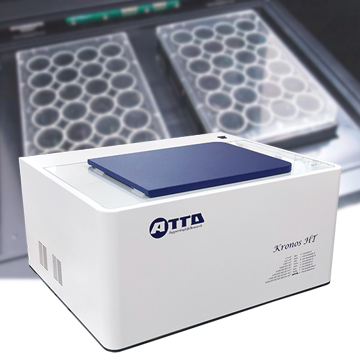
クロノスHTは、マルチウェルプレートで培養しながら細胞や組織におけるダイナミックな変化を、ルシフェラーゼによる生物発光の変動として検出する装置です。
- (Cytotoxicity) S. Wakuri, K. Yamakage, Y. Kazuki, K. Kazuki, M. Oshimura, S. Aburatani, M. Yasunaga and Y. Nakajima, Correlation between luminescence intensity and cytotoxicity in cell-based cytotoxicity assay using luciferase. Anal. Biochem., 522, 18-29 (2017)[PubMed]
- (Oxidative stress) Y. Tabei, K. Murotomi, A. Umeno, M. Horie, Y. Tsujino, B. Masutani, Y. Yoshida, Y. Nakajima, Antioxidant properties of 5-hydroxy-4-phenyl-butenolide via activation of Nrf2/ARE signaling pathway. Food Chem. Toxicol., 107(A), 129-137 (2017)[PubMed]
- (Micro RNA) Y. Mie, Y. Hirano, K. Kowata, A. Nakamura, M. Yasunaga, Y. Nakajima and Y. Komatsu, Function control of anti-microRNA oligonucleotides using interstrand cross-linked duplexes, Mol. Ther. Nucleic Acids, 10, 64-74 (2018)[PubMed]
- (Anti-inflammation) P. Saiki, Y. Kawano, Y. Nakajima, LJLD. Van Griensven and K. Miyazaki, Novel and stable dual-color IL-6 and IL-10 reporters derived from RAW 264.7 for anti-inflammation screening of natural products. Int. J. Mol. Sci., 20(18), 4620 (2019)[PubMed]
- (Cytotoxicity) S. Iwado, S. Abe, M. Oshimura, Y. Kazuki and Y. Nakajima, Bioluminescence measurement of time-dependent dynamic changes of CYP-mediated cytotoxicity in CYP-expressing luminescent HepG2 cells. Int. J. Mol. Sci., 22(6), 2843 (2021)[PubMed]
- (Clock gene) JS. Huh, S. Lee, DS. Kim, MS. Choi, H. Choi and KH. Lee, Antioxidative and circadian rhythm regulation effect of Quercus gilva extract. J. Korean Wood Sci. Technol., 50(5), 338-352 (2022)[Link]
LumiFLspectrocapture(AB-1850)
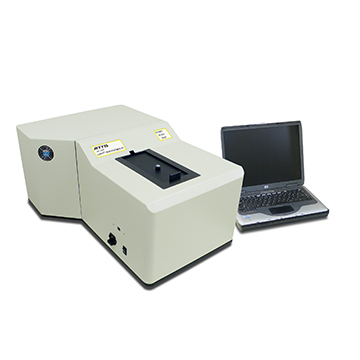
ルミフルスペクトロキャプチャーは、生物発光や化学発光等による非常に微弱な光(400~800nmの範囲)のスペクトルを、短時間に、対象波長領域全体をほぼ同時に測定することが出来る分光計測装置です。
発光プローブや蛍光プローブの開発や、蛍光・発光反応の解析などで威力を発揮します。
- Y. Nakajima, K. Kobayashi, K. Yamagishi, T. Enomoto and Y. Ohmiya, cDNA Cloning and Characterization of a Secreted Luciferase from the Luminous Japanese Ostracod, Cypridina noctiluca. Biosci. Biotechnol. Biochem., 68(3), 565-570 (2004)[PubMed]
- Y. Nakajima, T. Kimura, C. Suzuki and Y. Ohmiya, Improved Expression of Novel Red- and Green-emitting Luciferases of Phrixothrix Railroad Worms in Mammalian Cells. Biosci. Biotechnol. Biochem., 68(4), 948-951 (2004)[PubMed]
- Y. Nakajima, M. Ikeda, T. Kimura, S. Honma, Y. Ohmiya and K. Honma, Bidirectional role of orphan nuclear receptor RORα in clock gene transcriptions demonstrated by a novel reporter assay system. FEBS Lett., 565, 122-126 (2004)[PubMed]
- T. Otsuji, E. Okuda-Ashitaka, S. Kojima, H. Akiyama, S. Ito and Y. Ohmiya, Monitoring for dynamic biological processing by intramolecular bioluminescence resonance energy transfer system using secreted luciferase. Anal. Biochem., 329, 230-237 (2004)[PubMed]
- C. Suzuki, Y. Nakajima, H. Akimoto, C. Wu and Y. Ohmiya, A new additional reporter enzyme, dinoflagellate luciferase, for monitoring of gene expression in mammalian cells. Gene, 344, 61-66 (2005)[PubMed]
- Y. Ohmiya, S. Kojima, M. Nakamura and H. Niwa, Bioluminescence in the Limpet-Like Snail, Latia neritoides. Bull. Chem. Soc. Japan, 78(7), 1197-1205 (2005)[PubMed]
- Y. Nakajima, T. Kimura, K. Sugata, T. Enomoto, A. Asakawa, H. Kubota, M. Ikeda and Y. Ohmiya, Multicolor luciferase assay system: one-step monitoring of multiple gene expressions with a signal substrate. BioTechniques, 38(6), 891-894 (2005)[PubMed]
- M. Nakamura, M. Mamino, M. Masaki, S. Maki, R. Matsui, S. Kojima, T. Hirano, Y. Ohmiya and H. Niwa, Bioluminescence activity of Latia luciferin analogues: replacement of the 2,6,6-trimethylcyclohexene ring onto the methyl-substituted phenyl groups. Tetrahedron Lett., 46(1), 53-56 (2005)[Link]
- H. Kondo, T. Igarashi, S. Maki, H. Niwa, H. Ikeda and T. Hirano, Substituent effects on the kinetics for the chemiluminescence reaction of 6-arylimidazo[1,2-a]pyrazin-3(7H)-ones (Cypridina luciferin analogues): support for the single electron transfer (SET)–oxygenation mechanism with triplet molecular oxygen. Tetrahedron Lett., 46(45), 7701-7704 (2005)[Link]
- K. Mori, S. Maki, H. Niwa, H. Ikeda and T. Hirano, Real light emitter in the bioluminescence of the calcium-activated photoproteins aequorin and obelin: light emission from the singlet-excited state of coelenteramide phenolate anion in a contact ion pair. Tetrahedron, 62(26), 6272-6288 (2006)[Link]
- T. Noguchi, M. Ikeda, Y. Ohmiya and Y. Nakajima, Simultaneous monitoring of independent gene expression patterns in two types of cocultured fibroblasts with differernt color-emitting luciferase. BMC Biotechnol., 8, 40 (2008)[PubMed]
- K. Teranishi and O. Shimomura, Bioluminescence of the arm light organs of the luminous squid Watasenia scintillans. Biochim Biophys Acta, 1780(5), 784-792 (2008)[PubMed]
- C. Suzuki-Ogoh, C. Wu and Y. Ohmiya, C-terminal region of the active domain enhances enzymatic activity in dinoflagellate luciferase. Photochem. Photobiol. Sci., 7(2), 208-211 (2008)[PubMed]
- Y. Takenaka, H. Masuda, A. Yamaguchi, S. Nishikawa, Y. Shigeri, Y. Yoshida, and H. Mizuno, Two forms of secreted and thermostable luciferases from the marine copepod crustacean, Metridia pacifica. Gene, 425(1-2), 28-35 (2008)[PubMed]
- T. Hirano, Y. Takahashi, H. Kondo, S. Maki, S. Kojima, H. Ikeda and H. Niwa, The reaction mechanism for the high quantum yield of Cypridina (Vargula) bioluminescence supported by the chemiluminescence of 6-aryl-2-methylimidazo[1,2-a]pyrazin-3(7H)-ones (Cypridina luciferin analogues). Photochem. Photobiol. Sci., 7(2), 197-207 (2008)[PubMed]
- C. Wu, K. Mino, H. Akimoto, M. Kawabata, K. Nakamura, M. Ozaki and Y. Ohmiya, In vivo far-red luminescence imaging of a biomarker based on BRET from Cypridina bioluminescence to an organic dye. Proc. Natl. Acad. Sci. USA, 106(37), 15599-15603 (2009)[PubMed]
- T. Noguchi, T. Michihata, W. Nakamura, T. Takumi, R. Shimizu, M. Yamamoto, M. Ikeda, Y. Ohmiya and Y. Nakajima, Dual-Color Luciferase Mouse Directly Demonstrates Coupled Expression of Two Clock Genes. Biochemistry, 49(37), 8053-8061 (2010)[PubMed]
- Y. Nakajima, T. Yamazaki, S. Nishii, T. Noguchi, H. Hoshino, K. Niwa, VR. Viviani, Y. Ohmiya, Enhanced Beetle Luciferase for High-Resolution Bioluminescence Imaging. PLoS One, 5(4), e10011 (2010)[PubMed]
- R. Ogura, N. Matsuo and K. Hiratsuka, Bioluminescence spectra of click beetle luciferase in higher plant cells. Plant Biotechnol., 28(4), 423-426 (2011)[Link]
- C. Wu, K. Kawasaki, S. Ohgiya and Y. Ohmiya, Chemical studies on the BRET system between the bioluminescence of Cypridina and quantum dots. Photochem. Photobiol. Sci., 10(10), 1531-1534 (2011)[PubMed]
- AKM. Kafi, M. Hattori, N. Misawa and T. Ozawa, Dual-Color Bioluminescence Analysis for Quantitatively Monitoring G-Protein-Coupled Receptor and β-Arrestin Interactions. Pharmaceuticals, 4(3), 457-469 (2011)[Link]
- D. Kato, K. Yokoyama, Y. Hiraishi, M. Takeo and S. Negoro, Comparison of Acyl-CoA Synthetic Activities and Enantioselectivity toward 2-Arylpropanoic Acids in Firefly Luciferases. Biosci. Biotechnol Biochem., 75(9), 1758-1762 (2011)[PubMed]
- SB. Kim, Y. Ito, and M. Torimura, Bioluminescent Capsules for Live-Cell Imaging. Bioconjug. Chem., 23(11), 2221-2228 (2012)[PubMed]
- SB. Kim, M. Torimura and H. Tao, Creation of Artificial Luciferases for Bioassays. Bioconjug. Chem., 24(12), 2067-2075 (2013)[PubMed]
- SB. Kim, T. Suzuki and A. Kimura, A Bioluminescent Assay System for Whole-Cell Determination of Hormones. Chem. Pharm. Bull., 61(7), 706-713 (2013)[PubMed]
- Y. Takenaka, A. Noda-Ogura, T. Imanishi, A. Yamaguchi, T. Gojobori and Y. Shigeri, Computational analysis and functional expression of ancestral copepod luciferase. Gene, 528(2), 201-205 (2013)[PubMed]
- S. Iwano, R. Obata, C. Miura, M. Kiyama, K. Hama, M. Nakamura, Y. Amano, S. Kojima, T. Hirano, S. Maki and H. Niwa, Development of simple firefly luciferin analogs emitting blue, green, red, and near-infrared biological window light. Tetrahedron, 69(19), 3847-3856 (2013)[Link]
- C. Miura, M. Kiyama, S. Iwano, K. Ito, R. Obata, T. Hirano, S. Maki and H. Niwa, Synthesis and luminescence properties of biphenyl-type firefly luciferin analogs with a new, near-infrared light-emitting bioluminophore. Tetrahedron, 69(46), 9726-9734 (2013)[Link]
- M. Hattori, S. Haga, H. Takakura, M. Ozaki, and T. Ozawa, Sustained accurate recording of intracellular acidification in living tissues with a photo-controllable bioluminescent protein. Proc. Natl. Acad. Sci. USA, 110(23), 9332-9337 (2013)[PubMed]
- D. Kato, T. Kubo, M. Maenaka, K. Niwa, Y. Ohmiya, M. Takeo and S. Negoro, Confirmation of color determination factors for Ser286 derivatives of firefly luciferase from Luciola cruciata (LUC-G). J. Mol. Catal. B Enzym., 87, 18-23 (2013)[Link]
- SB. Kim and H. Izumi, Functional artificial luciferases as an optical readout for bioassays. Biochem. Biophys. Res. Commun., 448(4), 418-423 (2014)[PubMed]
- M. Yasunaga, Y. Nakajima and Y. Ohmiya, Dual-color bioluminescence imaging assay using green- and red-emitting beetle luciferases at subcellular resolution. Anal. Bioanal. Chem., 406(23), 5735-5742 (2014)[PubMed]
- Y. Ishii, C. Hayashi, Y. Suzuki and T. Hirano, Chemiluminescent 2,6-diphenylimidazo[1,2-a]pyrazin-3(7H)-ones: a new entry to Cypridina luciferin analogues. Photochem. Photobiol. Sci., 13(2), 182-189 (2014)[PubMed]
- D. Kato, D. Shirakawa, R. Polz, M. Maenaka, M. Takeo, S. Negoro and K. Niwa, A firefly inspired one-pot chemiluminescence system using n-propylphosphonic anhydride (T3P). Photochem. Photobiol. Sci., 13(12), 1640-1645 (2014)[PubMed]
- SB. Kim, S. Miller, N. Suzuki, T. Senda, R. Nishihara and K. Suzuki, Cation-driven Optical Properties of Artificial Luciferases. Anal. Sci., 31(10), 955-960 (2015)[PubMed]
- T. Nishiguchi, T. Yamada, Y. Nasu, M. Ito, H. Yoshimura and T. Ozawa, Development of red-shifted mutants derived from luciferase of Brazilian click beetle Pyrearinus termitilluminans. J. Biomed. Opt., 20(10), 101205 (2015)[PubMed]
- GVM. Gabriel and VR. Viviani, Engineering the metal sensitive sites in Macrolampis sp2 firefly luciferase and use as a novel bioluminescent ratiometric biosensor for heavy metals. Anal. Bioanal. Chem., 408(30), 8881-8893 (2016)[PubMed]
- DT. Amaral, G. Oliveira, JR. Silva and VR. Viviani, A new orange emitting luciferase from the Southern-Amazon Pyrophorus angustus (Coleoptera: Elateridae) click-beetle: structure and bioluminescence color relationship, evolutional and ecological considerations. Photochem. Photobiol. Sci., 15(9), 1148-1154 (2016)[PubMed]
- S. Ioka, T. Saitoh, S. Iwano, K. Suzuki, S. Maki, A. Miyawaki, M. Imoto and S. Nishiyama, Synthesis of Firefly Luciferin Analogues and Evaluation of the Luminescent Properties. Chemistry, 22(27), 9330-9337 (2016)[PubMed]
- SB. Kim, R. Nishihara, D. Citterio and K. Suzuki, Genetically Encoded Molecular Tension Probe for Tracing Protein–Protein Interactions in Mammalian Cells. Bioconjug. Chem., 27(2), 354-362 (2016)[PubMed]
- T. Kuchimaru, S. Iwano, M. Kiyama, S. Mitsumata, T. Kadonosono, H. Niwa, S. Maki and S. Kizaka-Kondoh, A luciferin analogue generating near-infrared bioluminescence achieves highly sensitive deep-tissue imaging. Nat. Commun., 7, 11856 (2016)[PubMed]
- M. Kakiuchi, S. Ito, M. Yamaji, VR. Viviani, S. Maki and T. Hirano, Spectroscopic Properties of Amine-substituted Analogues of Firefly Luciferin and Oxyluciferin. Photochem. Photobiol., 93(2), 486-494 (2017)[PubMed]
- K. Teranishi, Second bioluminescence-activating component in the luminous fungus Mycena chlorophos. Luminescence, 32(2), 182-189 (2017)[PubMed]
- K. Teranishi, Inhibition of bioluminescence in the living gills of the luminous fungus Mycena chlorophos by trans-4-aminocinnamic acid. Biochem. Biophys. Res. Commun., 488(2), 335-339 (2017)[PubMed]
- SB. Kim, R. Nishihara, D. Citterio and K. Suzuki, Fabrication of a new lineage of artificial luciferases from natural luciferase pools. ACS Comb. Sci., 19(9), 594-599 (2017)[PubMed]
- N. Noda, R. Awais, R. Sutton, M. Awais and T. Ozawa, Dynamic monitoring of p53 translocation to mitochondria for the analysis of specific inhibitors using luciferase-fragment complementation. Biotechnol. Bioeng., 114(12), 2818-2827 (2017)[PubMed]
- M. Kiyama, S. Iwano, S. Otsuka, SW. Lu, R. Obata, A. Miyawaki, T. Hirano and SA. Maki, Quantum yield improvement of red-light-emitting firefly luciferin analogues for in vivo bioluminescence imaging. Tetrahedron, 74(6), 652-660 (2018)[Link]
- R. Nishihara, E. Hoshino, Y. Kakudate, S. Kishigami, N. Iwasawa, S. Sasaki, T. Nakajima, M. Sato, S. Nishiyama, D. Citterio, K. Suzuki and SB. Kim, Azide- and dye-conjugated coelenterazine analogues for a multiplex molecular imaging platform. Bioconjug. Chem., 29(6), 1922-1931 (2018)[PubMed]
- K. Teranishi, Bioluminescence and chemiluminescence abilities of trans-3-hydroxyhispidin on the luminous fungus Mycena chlorophos. Luminescence, 33(7), 1235-1242 (2018)[PubMed]
- R. Saito, T. Kuchimaru, S. Higashi, SW. Lu, M. Kiyama, S. Iwano, R. Obata, T. Hirano, S. Kizaka-Kondoh and SA. Maki, Synthesis and luminescence properties of near-infrared N-heterocyclic luciferin analogues for in vivo optical imaging. Bull. Chem. Soc. Jpn., 92(3), 608-618 (2019)[Link]
- N. Nomura, R. Nishihara, T. Nakajima, SB. Kim, N. Iwasawa, Y. Hiruta, S. Nishiyama, M. Sato, D. Citterio and K. Suzuki, Biothiol-activatable bioluminescent coelenterazine derivative for molecular imaging in vitro and in vivo. Anal. Biochem., 91(15), 9546-9553 (2019)[PubMed]
- R. Nishihara, R. Paulmurugan, T. Nakajima, E. Yamamoto, A. Natarajan, R. Afjei, Y. Hiruta, N. Iwasawa, S. Nishiyama, D. Citterio, M. Sato, SB. Kim and K. Suzuki, Highly bright and stable NIR-BRET with blue-shifted coelenterazine derivatives for deep-tissue imaging of molecular events in vivo. Theranostics, 9(9), 2646-2661 (2019)[PubMed]
- M. Abe, R. Nishihara, Y. Ikeda, T. Nakajima, M. Sato, N. Iwasawa, S. Nishiyama, R. Paulmurugan, D. Citterio, SB. Kim and K. Suzuki, Near infrared bioluminescence imaging with through-bond energy transfer cassette. Chembiochem., 20(15), 1919-1923 (2019)[PubMed]
- GC. Liu, R. Zhang, QB. Hou, JW. He, ZW. Dong, RP. Zhao, W. Wang and XY. Li, Cloning and characterization of luciferase from the Chinese firefly Lamprigera yunnana. Photochem. Photobiol., 95(5), 1186-1194 (2019)[PubMed]
- GC. Liu, ZW. Dong, QB. Hou, JW. He, RP. Zhao, W. Wang and XY. Li, Second Rhagophthalmid luciferase cloned from Chinese glow-worm Menghuoius giganteus (Rhagophthalmidae: Elateroidea). Photochem. Photobiol., 96(1), 46-54 (2020)[PubMed]
- K. Ogoh, R. Akiyoshi and H. Suzuki, Cloning and mutagenetic modification of the firefly luciferase gene and its use for bioluminescence microscopy of engrailed expression during Drosophila metamorphosis. Biochem. Biophys. Rep., 23, 100771 (2020)[PubMed]
- N. Kitada, R. Saito, R. Obata, S. Iwano, K. Karube, A. Miyawaki, T. Hirano and SA. Maki, Development of near-infrared firefly luciferin analogue reacted with wild-type and mutant luciferases. Chirality, 32(7), 922-931 (2020)[PubMed]
- J. Nakayama, R. Saito, Y. Hayashi, N. Kitada, S. Tamaki, Y. Han, K. Semba and SA. Maki, High sensitivity in vivo imaging of cancer metastasis using a near-infrared luciferin analogue seMpai. Int. J. Mol. Sci., 21(21), 7896 (2020)[PubMed]
- Y. Oba, K. Konishi, D. Yano, H. Shibata, D. Kato and T. Shirai, Resurrecting the ancient glow of the fireflies. Sci. Adv., 6(49), eabc5705 (2020)[PubMed]
- Y. Mizui, M. Eguchi, M. Tanaka, Y. Ikeda, H. Yoshimura, T. Ozawa, D. Citterio and Y. Hiruta, Long-term single cell bioluminescence imaging with C-3 position protected coelenterazine analogues. Org. Biomol. Chem., 19(3), 579-586 (2021)[PubMed]
- S. Tamaki, N. Kitada, M. Kiyama, R. Fujii, T. Hirano, SB. Kim and S. Maki, Color‑tunable bioluminescence imaging portfolio for cell imaging. Sci. Rep., 11(1), 2219 (2021)[PubMed]
- JW. He, GC. Liu, PX. Dong, ZW. Dong, RP. Zhao, W. Wang and XY. Li, Molecular cloning, characterization, and evolution analysis of the luciferase genes from three sympatric sibling fireflies (Lampyridae: Lampyrinae, Diaphanes). Photocem. Photobiol. Sci., 20(8), 1053-1067 (2021)[PubMed]
- K. Teranishi, Non-invasive and accurate readout of superoxide anion in biological systems by near-infrared light. Anal. Chim. Acta., 1179, 338827 (2021)[PubMed]
- S. Kanie, D. Miura, N. Jimi, T. Hayashi, K. Nakamura, M. Sakata, K. Ogoh, Y. Ohmiya and Y. Mitani, Violet bioluminescent Polycirrus sp. (Annelida: Terebelliformia) discovered in the shallow coastal waters of the Noto Peninsula in Japan. Sci. Rep., 11(1), 19097 (2021)[PubMed]
- E. Belleti, VR. Bevilaqua, AMM. Brito, DA. Modesto, AJC. Lanfredi, VR. Viviani and IL. Nantes‑Cardoso, Synthesis of bioluminescent gold nanoparticle–luciferase hybrid systems for technological applications. Photochem. Photobiol. Sci., 20(11), 1439-1453 (2021)[PubMed]
- Y. Ikeda, M. Orioka, T. Nomoto, Y. Hiruta, N. Nishiyama and D. Citterio, Differential Effect of azetidine substitution in firefly luciferin analogues. Chembiochem, 22(21), 3067-3074 (2021)[PubMed]
CLuc
Clucレポーターアッセイキットは、ウミホタル由来の分泌型ルシフェラーゼの遺伝子・ベクターと発光基質を含む、レポーターアッセイキットです。
細胞外に分泌されるという特長を持ち、細胞毒性も低いことから、長期間の培養に対応できる他、細胞や組織外に分泌されたルシフェラーゼを回収しつつ経時的な変化を調べるexo vivoの測定系を作ることが出来ます。
- (Cluc cloning) Y. Nakajima, K. Kobayashi, K. Yamagishi, T. Enomoto and Y. Ohmiya, cDNA Cloning and Characterization of a Secreted Luciferase from the Luminous Japanese Ostracod, Cypridina noctiluca. Biosci. Biotechnol. Biochem., 68(3), 565-570 (2004)[PubMed]
- (Mammal) K. Yamagishi, T. Enomoto and Y. Ohmiya, Perfusion-culture-based secreted bioluminescence reporter assay in living cells. Anal. Biochem., 354(1), 15-21 (2006)[PubMed]
- (Mammal) C. Wu, C. Suzuki-Ogoh and Y. Ohmiya, Dual-reporter assay using two secreted luciferase genes. Biotechniques, 42(3), 290-292 (2007)[PubMed]
- (Yeast) N. Kanjou, A. Nagao, Y. Ohmiya and S. Ohgiya, Yeast mutant with efficient secretion identified by a novel secretory reporter, Cluc. Biochem. Biophys. Res. Commun., 358(2), 429-434 (2007)[PubMed]
- (Mammal) K. Nishimura, H. Segawa, T. Goto, M. Morishita, A. Masago, H. Takahashi, Y. Ohmiya, T. Sakaguchi, M. Asada, T. Imamura, K. Shimotono, K. Takayama, T. Yoshida, and M. Nakanishi, Persistent and Stable Gene Expression by a Cytoplasmic RNA Replicon Based on a Noncytopathic Variant Sendai Virus. J. Biol. Chem., 282(37), 27383-27391 (2007)[PubMed]
- (Mammal) C. Wu, K. Mino, H. Akimoto, M. Kawabata, K. Nakamura, M. Ozaki and Y. Ohmiya, In vivo far-red luminescence imaging of a biomarker based on BRET from Cypridina bioluminescence to an organic dye. Proc. Natl. Acad. Sci. USA, 106(37), 15599-15603 (2009)[PubMed]
- (Yeast) H. Abe, Y. Takaoka, Y. Chiba, N. Sato, S. Ohgiya, A. Itadani, M. Hirashima, C. Shimoda, Y. Jigami and K. Nakayama, Development of valuable yeast strains using a novel mutagenesis technique for the effective production of therapeutic glycoproteins. Glycobiology, 19(4), 428-436 (2009)[PubMed]
- (Mammal) M. Okayama, T. Arakawa, A. Tanimura, I. Mizoguchi, Y. Tajima and T. Takuma, Role of VAMP8/endobrevin in Constitutive Exocytotic Pathway in HeLa Cells. Cell Struct. Funct., 34(2), 115-125 (2009)[PubMed]
- (Mammal) T. Watanabe, T. Enomoto, M. Takahashi, S. Honma, K. Honma andY. Ohmiya, Multichannel perfusion culture bioluminescence reporter system for long-term detection in living cells. Anal. Biochem., 402(1), 107-109 (2010)[PubMed]
- (Yeast) Y. Tochigi, N. Sato, T. Sahara, C. Wu, S. Saito, T. Irie, W. Fujibuchi, T. Goda, R. Yamaji, M. Ogawa, Y. Ohmiya and Satoru Ohgiya, Sensitive and Convenient Yeast Reporter Assay for High-Throughput Analysis by Using a Secretory Luciferase from Cypridina noctiluca. Anal. Chem., 82(13), 5768-5776 (2010)[PubMed]
- (Q dot) C. Wu, K. Kawasaki, S. Ohgiya and Y. Ohmiya, Chemical studies on the BRET system between the bioluminescence of Cypridina and quantum dots. Photochem. Photobiol. Sci., 10(10), 1531-1534 (2011)[PubMed]
- (Mammal) K. Nishimura, M. Sano, M. Ohtaka, B. Furuta, Y. Umemura, Y. Nakajima, Y. Ikehara, T. Kobayashi, H. Segawa, S. Takayasu, H. Sato, K. Motomura, E. Uchida, T. Kanayasu-Toyoda, M. Asashima, H. Nakauchi, T. Yamaguchi, and M. Nakanishi, Development of Defective and Persistent Sendai Virus Vector. J. Biol. Chem., 286(6), 4760-4771 (2011)[PubMed]
- (Mammal) J. Hamuro, Y. Hishida, O. Higuchi and Y. Yamanashi, The transcription factor Sp1 plays a crucial role in dok-7 gene expression. Biochem. Biophys. Res. Commun., 408(2), 293-299 (2011)[PubMed]
- (Yeast) Y. Ochi, H. Sugawara, M. Iwami, M. Tanaka and T. Eki, Sensitive detection of chemical-induced genotoxicity by the Cypridina secretory luciferase reporter assay, using DNA repair-deficient strains of Saccharomyces cerevisiae. Yeast, 28(4), 265-278 (2011)[PubMed]
- (Mammal) T. Arakawa, T. Ohta, Y. Abiko, M. Okayama, I. Mizoguchi and T. Takuma, A polymerase chain reaction-based method for constructing a linear vector with site-specific DNA methylation. Anal. Biochem., 416(2), 211-217 (2011)[PubMed]
- (Mammal) HJ. Kwon, Y. Ohmiya, K. Honma, S. Honma, T. Nagai, K. Saito and K. Yasuda, Synchronized ATP oscillations have a critical role in prechondrogenic condensation during chondrogenesis. Cell Death Dis., 3, e278 (2012)[PubMed]
- (Mammal) HJ. Kwon, Extracellular ATP signaling via P2X4 receptor and cAMP/PKA signaling mediate ATP oscillations essential for prechondrogenic condensation. J. Endocrinol., 214(3), 337-348 (2012)[PubMed]
- (Yeast) T. Fukunaga, K. Cha-aim, Y. Hirakawa, R. Sakai, T. Kitagawa, M. Nakamura, S. Nonklang, H. Hoshida and R. Akada, Designed construction of recombinant DNA at the ura3Δ0 locus in the yeast Saccharomyces cerevisiae. Yeast, 30(6), 243-253 (2013)[PubMed]
- (Mammal) A. Shitara, T. Shibui, M. Okayama, T. Arakawa, I. Mizoguchi, Y. Shakakura and T. Takuma, VAMP4 is required to maintain the ribbon structure of the Golgi apparatus. Mol. Cell Biochem., 380(1-2), 11-21 (2013)[PubMed]
- (Mammal) Y. Yamada, S. Nishide, Y. Nakajima, T. Watanabe, Y. Ohmiya, K. Honma and S. Honma, Monitoring circadian time in rat plasma using a secreted Cypridina luciferase reporter. Anal. Biochem., 439(2), 80-87 (2013)[PubMed]
- (Mammal) T. Zhao, Y. Zhu, A. Morinibu, M. Kobayashi, K. Shinomiya, S. Itasaka, M. Yoshimura, G. Guo, M. Hiraoka and H. Harada, HIF-1-mediated metabolic reprogramming reduces ROS levels and facilitates the metastatic colonization of cancers in lungs. Sci. Rep., 4, 3793 (2014)[PubMed]
- (Mammal) HJ. Kwon and Y. Han, Dual Monitoring of Secretion and ATP Levels during Chondrogenesis Using Perfusion Culture-Combined Bioluminescence Monitoring System. Biomed. Res. Int., 219068 (2015)[PubMed]
- (Yeast) T. Yarimizu, M. Nakamura, H. Hoshida, R. Akada, Screening of accurate clones for gene synthesis in yeast. J. Biosci. Bioeng., 119(3), 251-259 (2015)[PubMed]
- (Mammal) Y. Ohmiya, Simultaneous multicolor luciferase reporter assays for monitoring of multiple genes expressions. Comb. Chem. High Throughput Screen., 18(10), 937-945 (2015)[PubMed]
- (Mammal) N. Morita, S. Haga, Y. Ohmiya and M. Ozaki, Long-term ex vivo and in vivo monitoring of tumor progression by using dual luciferases. Anal. Biochem., 497, 24-26 (2016)[PubMed]
- (Yeast) H. Hoshida, M. Kondo, T. Kobayashi, T. Yarimizu and R. Akada, 5´-UTR introns enhance protein expression in the yeast Saccharomyces cerevisiae. Appl. Microbiol. Biotechnol., 101(1), 241-251 (2016)[PubMed]
- (Plant) Y. Mitani, Y. Oshima, N. Mitsuda, A. Tomioka, M. Sukegawa, M. Fujita, H. Kaji, Y. Ohmiya, Efficient production of glycosylated Cypridina luciferase using plant cells. Protein Expr. Purif., 133, 102-109 (2017)[PubMed]
- (Mammal) K. Nishimura, M. Ohtaka, H. Takada, A. Kurisaki, MVK. Tran, YTH. Tran, K. Hisatake, M. Sano and M. Nakanishi, Simple and effective generation of transgene-free induced pluripotent stem cells using an auto-erasable Sendai virus vector responding to microRNA-302. Stem Cell Res., 23, 13-19 (2017)[PubMed]
- (Mammal) R. Yasuno, Y. Mitani and Y. Ohmiya, Effects of N-Glycosylation Deletions on Cypridina Luciferase Activity. Photochem. Photobiol., 94(2), 338-342 (2018)[PubMed]
- (Mammal) M. Minegishi, T. Kuchimaru, K. Nakagawa, T. Isozaki, S. Fujimori, T. Kadonosono and S. Kizaka-Kondoh, Multiplexed bioluminescence imaging of cancer cell response to hypoxia and inflammation in the caudalartery injection model of bone metastasis during zoledronic acid treatment. J. Cancer Metastasis Treat., 7:5 (2021)[Link]
MPEC(AB-2950)
MPECは、スーパーオキシドと特異的に反応する発光試薬です。従来の発光試薬よりも中性溶液中で高いS/Nが得られます。
- Osamu Shimomura, Chun Wu, Akio Murai, and Hideshi Nakamura. Evaluation of Five Imidazopyrazinone-Type Chemiluminescent Superoxide Probes and Their Application to the Measurement of Superoxide Anion Generated by Listeria monocytogenes. Anal.Biochem. 1998, 258 (2) 230-5
- Naoyuki Kitagawa, Shun Shimohama, Tomoko Oeda, Kengo Uemura, Ryuichi Kohno, Akira Kuzuya, Hiroshi Shibasaki, and Naoaki Ishii. The Role of the Presenilin-1 Homologue Gene sel-12 of Caenorhabditis elegans in Apoptotic Activities. J Biol. Chem.vol.278 no.14, 12130-12134, 2003
- Nanami Senoo-Matsuda, Philip S. Hartman, Akira Akatsuka, Shinichi Yoshimura, and Naoaki Ishii. A Complex II Defect Affects Mitochondrial Structure, Leading to ced-3- and ced-4-dependent Apoptosis and Aging. J Biol. Chem.vol.278 no.24, 22031-22036, 2003
- Michihiko Fujii, Yuki Matsumoto, Nanae Tanaka, Kensuke Miki, Toshikazu Suzuki,Naoaki Ishii, and Dai Ayusawa. Mutations in Chemosensory Cilia Cause Resistance to Paraquat in Nematode Caenorhabditis elegans. J Biol. Chem.vol.279 no.19, 20277-20282, 2004
- Daisuke Nakai, Takahiko Shimizu, Hidetoshi Nojiri, Satoshi Uchiyama, Hideo Koike, Mayumi Takahashi, Katsuiku Hirokawa and Takuji Shirasawa. coq7/clk-1 regulates mitochondrial respiration and the generation of reactive oxygen species via coenzyme Q. Aging Cell (2004) 3,pp273-281
- Motoichi Kurisawa, Joo Eun Chung, Hiroshi Uyama and Shiro Kobayashi.Oxidative coupling of epigallocatechin gallate amplifies antioxidant activity and inhibits xanthine oxidase activity. Chem. Commun. 2004 Feb 7; (3):294-5
- Takamasa Ishii, Kayo Yasuda, Akira Akatsuka, Okio Hino, Philip S. Hartman, and Naoaki Ishii. A Mutation in the SDHC Gene of Complex Ⅱ Increases Oxidative Stress, Resulting in Apoptosis and Tumorigenesis. Cancer Research 65,203-209, January 1, 2005
- Ken-ichiro Yamamoto, Kazuyoshi Kobayashi, Kosuke Endo, Takehiro Miyasaka, Seiichi Mochizuki, Fukashi Kohori and Kiyotaka Sakai. Hollow-fiber blood-dialysis membranes: superoxide generation, permeation, and dismutation measured by chemiluminescence. J Artif Organs. 2005; 8(4):257-62.
- Hidetoshi Nojiri, Takahiko Shimizu, Masabumi Funakoshi, Osamu Yamaguchi, Heying Zhou, Satoru Kawakami, Yutaka Ohta, Manabu Sami, Toshiaki Tachibana, Hiroshi Ishikawa, Hisashi Kurosawa, Ronald Kahn, Kinya Otsu, and Takuji Shirasawa, Oxidative stress causes heart failure with impaired mitochondrial respiration. J Biol. Chem. 2006 Nov 3; 281(44):33789-801.
- Toshimitsu KUROKAWA, Shirou ITAGAKI, Toshihiko YAMAJI, Chie NAKATA, Toshihiro NODA,Takeshi HIRANO, and Ken ISEKI. Antioxidant Activity of a Novel Extract from Bamboo Grass (AHSS) against Ischemia-Reperfusion Injury in Rat Small Intestine. Biol. Pharm. Bull. 29(11) 2301—2303 (2006)
- Yoshihiro Saito, Daisuke Umemoto, Ai Matsunaga, Takaji Sato and Masahiko Chikuma. Antioxidant activities of Synthesized Selenocompounds without Selenol Groups. Biomed. Res. Trace. Elements 17 (4) 423-426(2006)
- Ohnuki H, Mizttani A and Otani H, Oral ingestion of cow’s milk immunoglobulin G stimulates some cellular immune systems and suppresses humoral immune responses in mouse. International Immunopharmacology 6 (8) 1315-1322 (2006)
- Ken-ichiro Yamamoto, Masato Matsuda, Masashi Okuoka, Taiji Yakushiji, Makoto Fukuda, Takehiro Miyasaka, Yutaka Matsumoto, Kiyotaka Sakai. Antioxidation property of vitamin E-coated polysulfone dialysis membrane and recovery of oxidized vitamin E by vitamin C treatment. J MEMBRANE SCI 01/2007; 302(1):115-118.
- Tsukagoshi K, Taniguchi T, Nakajima R. Analysis of antioxidants using a capillary electrophoresis with chemiluminescence detection system. Anal Chim Acta.2007 Apr 18; 589(1):66-70.
- Sumino Yanase and Naoaki Ishii. Hyperoxia Exposure Induced Hormesis Decreases Mitochondrial Superoxide Radical Levels via Ins/IGF-1 Signaling Pathway in a Long-living age-1 Mutant of Caenorhabditis elegans. J. Radiat. Res. 2008 May; 49(3):211-8
- Shinya Mitsuhashi, Akiko Saito, Noriyuki Nakajima, Hiroshi Shima and Makoto Ubukata. Pyrogallol Structure in Polyphenols is Involved in Apoptosis-induction on HEK293T and K562 Cells. Molecules2008, 13, 2998-3006
- Takuro Yamaguchi, Akira Onodera, Kayo Yasuda, Yasunori Nishio, Makoto Arai, Michio Tsuda, Masaki Miyazawa, Philip S. Hartman and Naoaki Ishii. A low cost and quick assay system using the free-living nematode Caenorhabditis elegans to determine the effects of Kampo medicines on life span. AATEX 13 (1) 1-10, 2008
- Masaki MIYAZAWA, Takamasa ISHII, Kayo YASUDA, Setsuko NODA, Hiromi ONOUCHI, Philip S. HARTMAN and Naoaki ISHII. The Role of Mitochondrial Superoxide Anion (O2–) on Physiological Aging in C57BL/6J Mice. J. Radiat. Res., 50, 73–82 (2009)
- Toru Sasaki, Analysis of Aging-related Oxidative Stress Status in Normal Aging Animals and Development of Anti-aging Interventions. YAKUGAKU ZASSHI 130(1) 29-42(2010) (In Japanese)
- Koumei Yazaki, Chinatsu Yoshikoshi, Satoru Oshiro, and Sumino Yanase. Supplemental Cellular Protection by a Carotenoid Extends Lifespan via Ins/IGF-1 Signaling in Caenorhabditis elegans. Oxidative Medicine and Cellular Longevity, Volume 2011, Article ID 596240, 9 pages
- Okutsu K, Yoshizaki Y, Takamine K, Tamaki H, Ito K, Sameshima Y. Development of a heat-processing method for koji to enhance its antioxidant activity. J.Bioaci.Bioeng vol113 no3 349-354(2012)
- Yuichi Uchino, Tetsuya Kawakita, Masaki Miyazawa, Takamasa Ishii, Hiromi Onouchi, Kayo Yasuda, Yoko Ogawa, Shigeto Shimmura, Naoaki Ishii, Kazuo Tsubota. Oxidative Stress Induced Inflammation Initiates Functional Decline of Tear Production. PLoS One. 2012; 7(10): e45805
- Kenji Miura, Ayaka Sato, Hayato Shiba, Seung Won Kanga, Hiroshi Kamada, Hiroshi Ezura. Accumulation of antioxidants and antioxidant activity in tomato, Solanum lycopersicum, are enhanced by the transcription factor SlICE1. Plant Biotechnology 29, 261-269 (2012)
- Shimada Hideaki, Yamaoka Yusuke, Morita Reiko, Mizuno Takayuki, Gotoh Kousei, Higuchi Toshiyuki, Shiraishi Takayuki, Imamura Yorishige. Possible mechanism of superoxide formation through redox cycling of plumbagin in pig heart. Toxicology in Vitro, 26 (2) 252-257, 2012
- Kaoru Akiyama, Yasuhiko Ohota and Kenji Tokunaga, Evalution of reactive oxigenproduction using whole blood samples by chemiluminescence. J. Analytical Bio-Science vol.35,No.2 (2012)(In Japanese)
- Shigeki Kobayashi and Sachi Kanai. Superoxide Scavenging Effects of Some Novel Bis-Ligands and Their Solvated Metal Complexes Prepared by the Reaction of Ligands with Aluminum, Copper and Lanthanum Ions. Molecules2013, 18, 6128-6141.
Fermograph(AF-1101W)
AF-1101Wファーモグラフは、パン生地中の酵母やもろみ中の清酒酵母等により発生する炭酸ガス量を、10~20検体平行して自動測定することが出来る装置です。
パン酵母の性能評価や品質管理、清酒酵母のアルコール生成能力の評価や代謝機構解析、バイオエタノール生産用酵母の育種などにも活用されています。
※ ファーモグラフIIは部品の生産終了により、2021年3月を以て生産・販売を終了させていただきました。長年のご愛顧、誠にありがとうございました。
- Pham Van Hung, Tomoko Maeda, Hiroaki Yamauchi, Naofumi Morita, Dough and breadmaking properties of various strong wheat grains cultivated in Japan. J. Appl. Glycosci., 52, 15-21 (2005)
- Kanenori Tanaka, Zenta Nishio, Norio Iriki, Tadashi Tabiki, Wakako Funatsuki, Hiroaki Yamanouchi, Comparison of Quality characteristics of waxy wheat using a near isogenic line, Breeding Science 55, 87-92 (2005)
- Sadako Takasaki, Yoji Kato, Masatsune Murata, Seiichi Homma, Shunro Kawakishi, Effects of peroxidase and hydrogen peroxide on the dityrosine formation and the mixing characteristics of wheat-flour dough, Biosci. Biotechnol. Biochem., 69(9), 1686-1692 (2005)
- Miwako Ito, Shun-Ju Kim, Zaidul-Islam Sarker, Naoto Hashimoto, Takahiro Noda, Shigenobu Takigawa, Chie Matsuura-Endo, Tetsuya Horibata, Yoshihiko Nakamura, Naoyoshi Inouchi, Michihiro Fukushima, Hiroaki Yamauchi, Staling and texture of bread prepared from new Japanese bread wheat varirties with slightly low-amylose starch, Food Sci. Technol. Res., 13(2), 121-128 (2007)
- Tomohiro Kaino, Tetsuya Tateiwa, Satomi Mizukami-Murata, Jun Shima, Hiroshi Takagi, Self-cloning baker's yeast that accumulate proline enhance freeze tolerance in doughs, Appl. Environ. Microbiol., 74(18), 5845-5849 (2008)
- Daisuke Watanabe, Tomonori Ota, Fusajiro Nitta, Takeshi Akao, Hitoshi Shimoi, Automatic measurement of sake fermentation kinetics using a multi-channel gas monitor system, J. Biosci. Bioeng., 112(1), 54-57 (2011)
- Daisuke Watanabe, Satoru Nogami, Yoshikazu Ohya, Yoichiro Kanno, Yan Zhou, Takeshi Akao, Hitoshi Shimoi, Ethanol fermentation driven by elevated expression of the G1 cyclin gene CLN3 in sake yeast, J. Biosci. Bioeng., 112(6), 577-582 (2011)
- Chiemi Noguchi, Daisuke Watanabe, Yan Zhou, Takeshi Akao, Hitoshi Shimoi, Association of constitutive hyperphosphorylation of Hsf1p with a defective ethanol stress response in Saccharomyces cervisiae sake yeast strains, Appl. Environ. Microbiol., 78(2), 385-392 (2012)
- Daisuke Watanabe, Yuya Araki, Yan Zhou, Naoki Maeya, Takeshi Akao, Hitoshi Shimoi, Appl. Environ. Microbiol., 78(11), 4008-4016 (2012)





